Dane.Kouttron
[6.10.20] Plague Times Are Strange Times
This is a 'blog' post listed under Story Time. Check there for more
rantings.
| What? |
MIT Closes Up Shop | Masks On | Go Kart Time | Makeshift Drive In | Hiking and Exercise | 360 Video | Image Directory | |
| NRL Install | Astro Photography | Dane's
Audio Book Reviews |
MIT Covid Testing |
| It begins: MIT closes up shop |
| From my perspective this got real in early February. Cases just began filtering into the states and working @ MIT (a fairly sizeable group of folks working in relatively tight quarters) was curious. There was not really any guidance, just things brewing early on. It was just under two months into the spring semester, so things were in full swing, but there was an air of uncertainty. |
Getting some space for
sanity, quickly: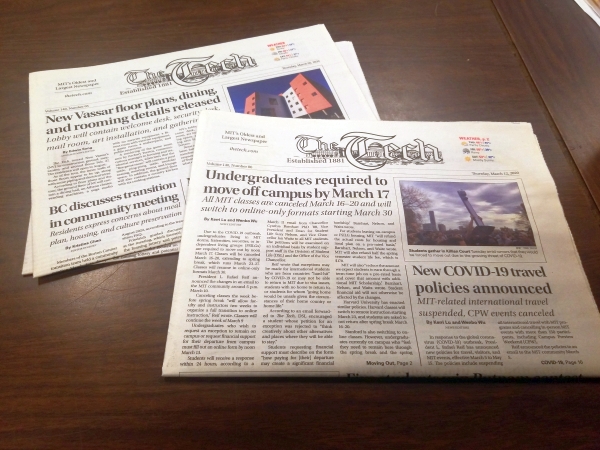 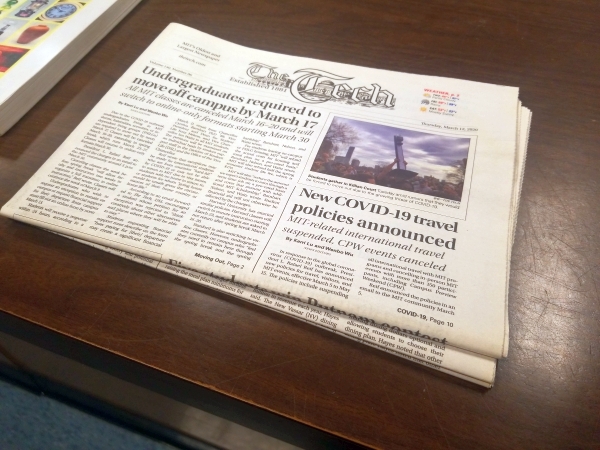 With the "undergrads out in 3 days" decree, I gave a hand where I could. Had I been in that position I'd be faced with a 'where the heck should all my stuff go' problem, should my cutesy Fusor end up in the recycling bin? What about that boat anchor of a power supply? I managed to get some lightly-used basement / storage space on Albany Street set aside for temporary storage for Nuclear Science undergrads / RX operators. It was fairly well received, and got some utilization. |
A guy with a Jeep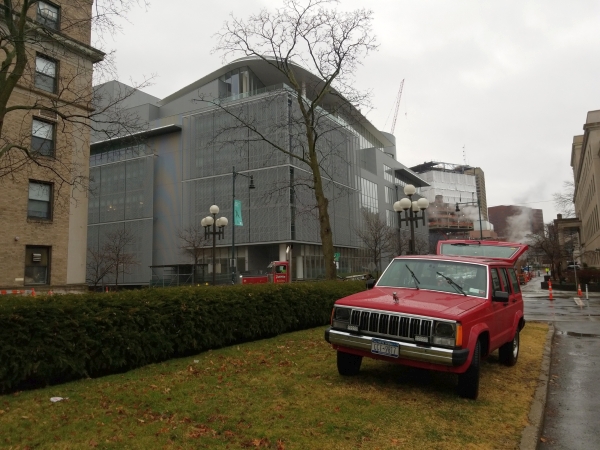 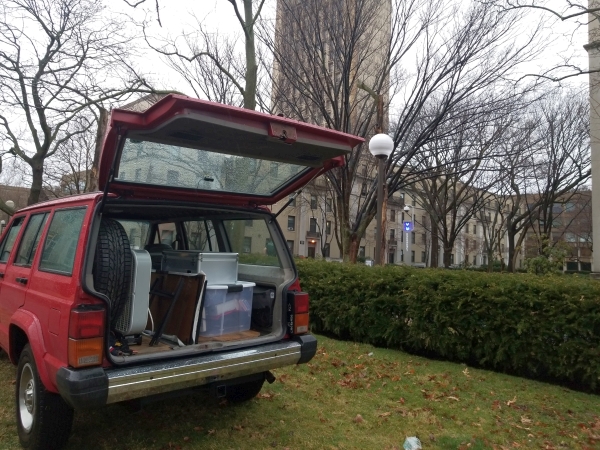 Let me paint the picture. Its cold and a bit rainy (of course its rainy). A couple hundred people are trying to re-locate, and cardboard boxes are at a premium. I ended up helping a few folks re-locate things down to 'temporary' storage on Albany street. Jake Miskie was kind enough to document this zoo a bit more thoroughly here [link]. |
Creative Parking and a slew of emails.  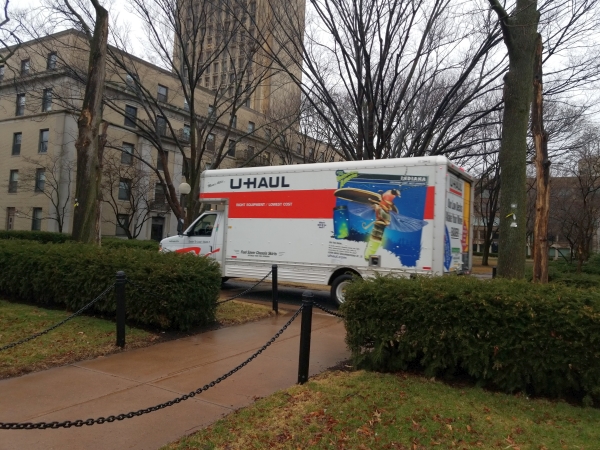 It was kind of funny how many sporadic emails looking for storage occurred during that period of time. Some Course 2 compatriots had half completed projects looking for homes, some of which ended up crated at home in my basement for the time being. The departure from campus was eery, everyone knew it was going to be hectic, but no one really wanted to interact in groups due to the many unknowns present at the time. |
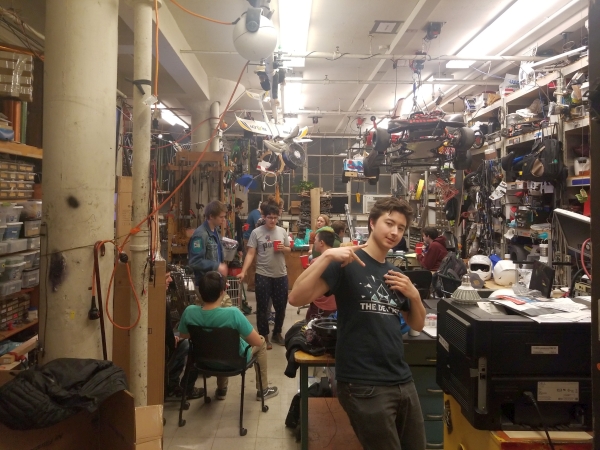 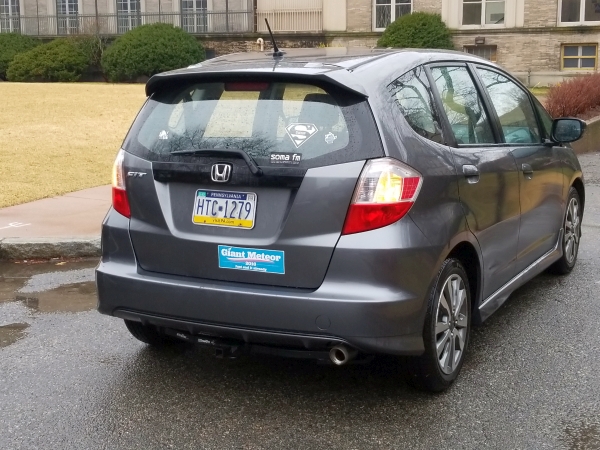 As you may know, I'm
fairly involved in a group called MITERS.
Shown right is the end-of-times party at miters before
everyone scattered about the states. As you may know, I'm
fairly involved in a group called MITERS.
Shown right is the end-of-times party at miters before
everyone scattered about the states. A number of miters denizens live over at East campus. With the short-notice from admins of 'we're closing up campus for the year', nearly every u-haul and rental vehicle evaporated in a fairly sizeable radius. Given that it was barely half way through the semester, a few EC folks decided to just rent a combined house out east. This began the east-campus invades cape-cod expedition. Shown far right was a great bumper sticker summarizing the year ahead. |
| A
surprisingly good email I checked in with Radiation Protection group to borrow their rather giant van. For reference, "Adding the EHS van to the GET FIT Program", the GET-FIT program [link] is an MIT exercise program where you log your exercise time and win... Dunkin Doughnuts gift cards or maybe a t shirt, Either way, this worked out and for-whatever reason was entrusted with a large van. |
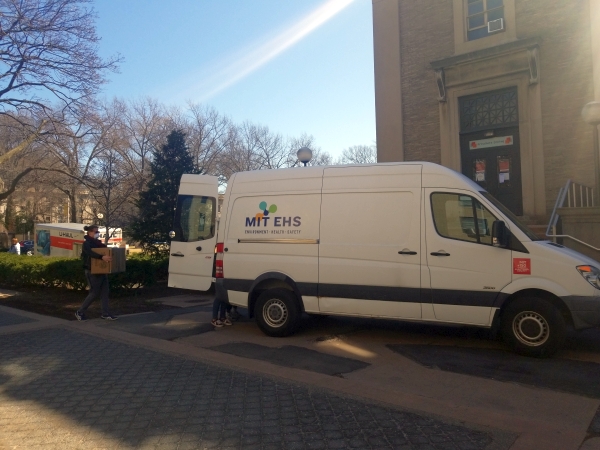 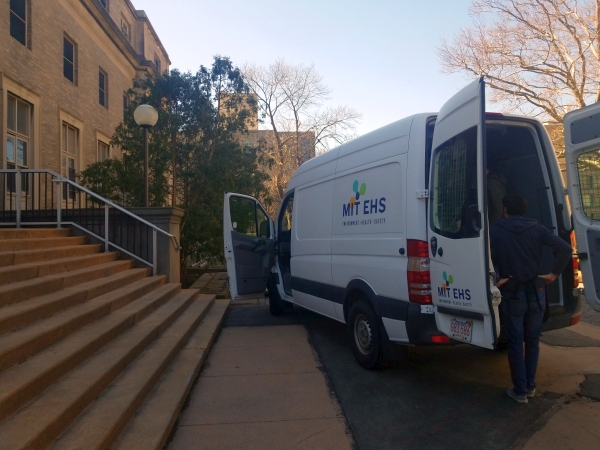 With
newfound access to a radiation protection van, thanks to
the ever-excellent Bill McCarthy it was time to load up. With
newfound access to a radiation protection van, thanks to
the ever-excellent Bill McCarthy it was time to load up.Lets take a step back here, like most campus vehicles, this particular van-agon spends a majority of its life parked. Now it was going to take a voyage down to Cape Cod and back. I cant thank Bill enough for lending this chariot out during those curious times. I checked the oil and transmission fluid levels, and was mildly envious of how little use this vehicle had seen. |
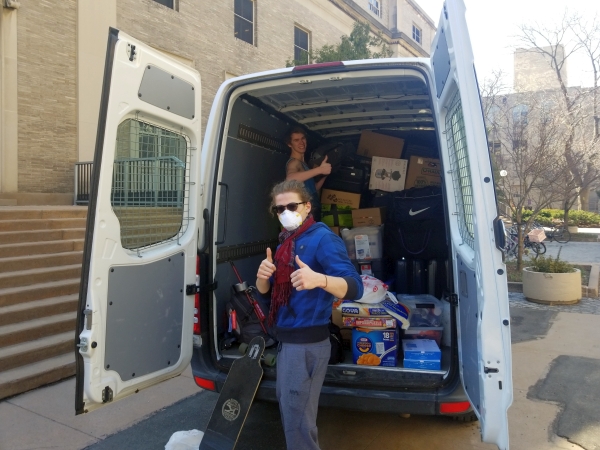 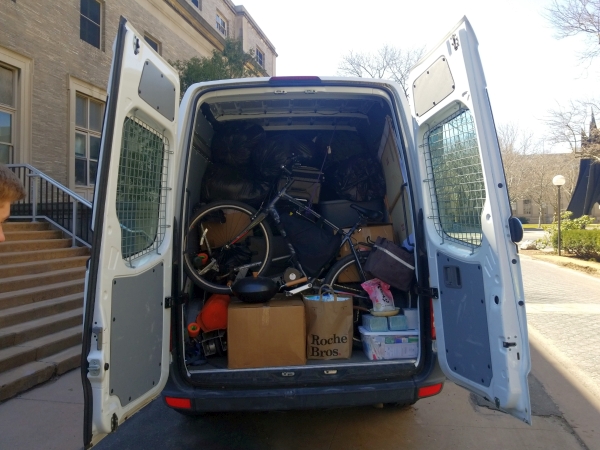 So
we loaded it up with 'essentials' for the trip down
south. Bicycles, plants, food, textbooks, and the like
all got piled in over the course of 45 minutes. A few
colleagues and alums brought over their personal
vehicles to help ferry what did not fit in the transport
van. Something like 16 undergrads stuff was packed in.The
ever excellent Savva
packing in contraptions and contraband. So
we loaded it up with 'essentials' for the trip down
south. Bicycles, plants, food, textbooks, and the like
all got piled in over the course of 45 minutes. A few
colleagues and alums brought over their personal
vehicles to help ferry what did not fit in the transport
van. Something like 16 undergrads stuff was packed in.The
ever excellent Savva
packing in contraptions and contraband. |
The
armada of assistants.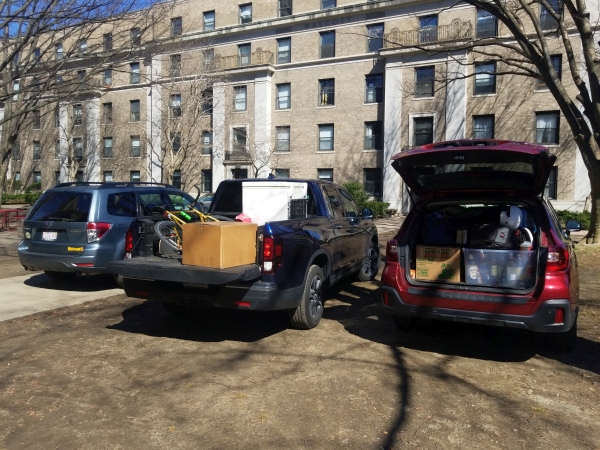 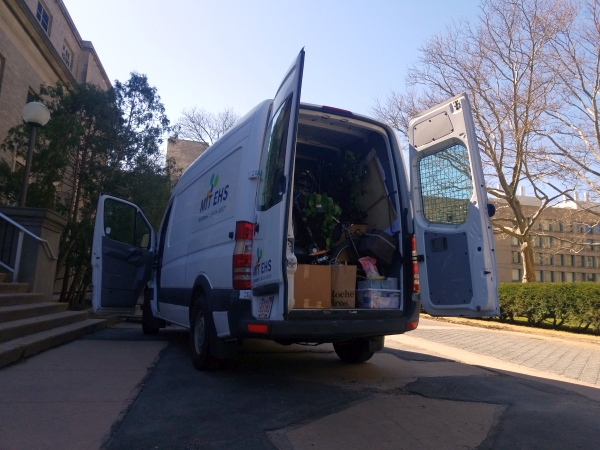 Friends and alums pitched in to help move folks down to the cape. I think shown is the Austin B mobile and an alum pickup. |
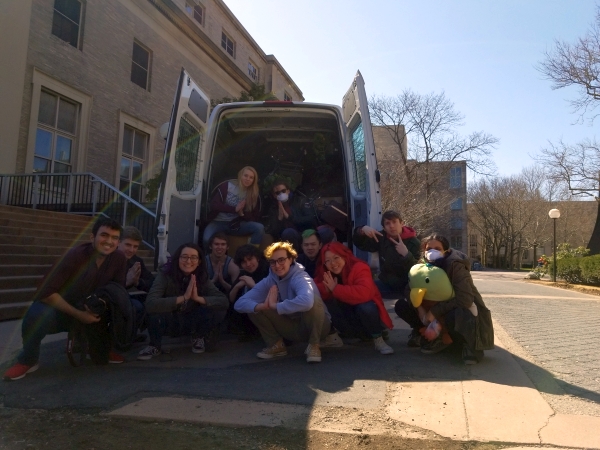 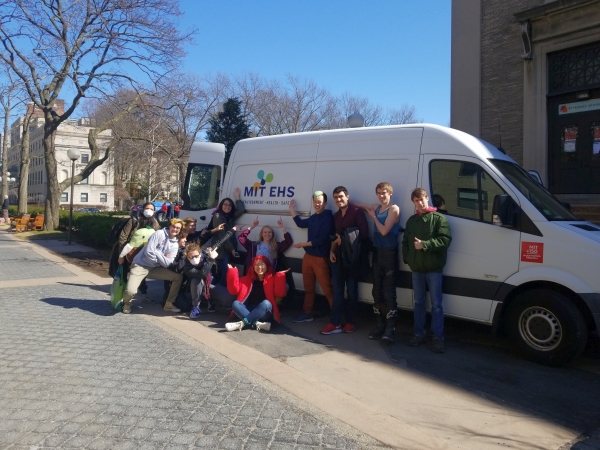 We
got a quick group photo and headed east. Keep in mind
this was March, so concepts of everyone wearing a mask,
gloves or keeping distance was still being worked out.
Nominally the known cases in the area were in the dozens
at this point, stemming from a recent biotech
conference. We
got a quick group photo and headed east. Keep in mind
this was March, so concepts of everyone wearing a mask,
gloves or keeping distance was still being worked out.
Nominally the known cases in the area were in the dozens
at this point, stemming from a recent biotech
conference. |
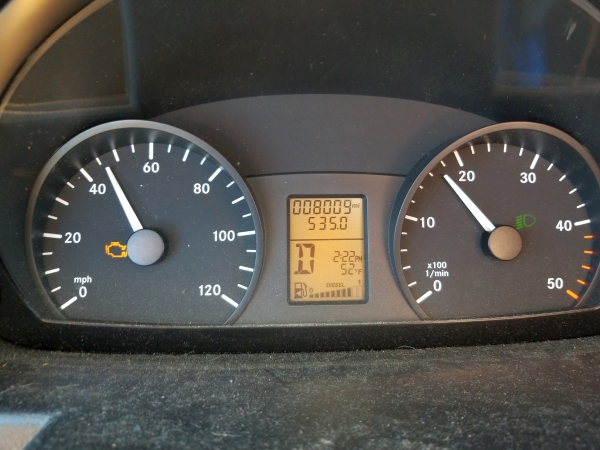 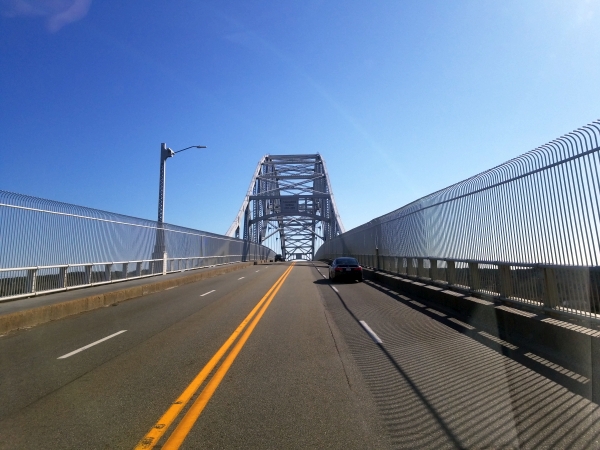 Had
I mentioned that this van was basically un-used. It had
accrued 8009 miles before departing (and a transmission warning light).
Have you driven a tall van on a windy day before?
Neither have I. One of the cape-cod area bridges
was especially windy, which made the ride all the more
interesting. Transmission warning light seemed to be
dependent on fuel-tank level which was curious. The
roads were quiet, the skies were clear, the year ahead
was going to get weird. Had
I mentioned that this van was basically un-used. It had
accrued 8009 miles before departing (and a transmission warning light).
Have you driven a tall van on a windy day before?
Neither have I. One of the cape-cod area bridges
was especially windy, which made the ride all the more
interesting. Transmission warning light seemed to be
dependent on fuel-tank level which was curious. The
roads were quiet, the skies were clear, the year ahead
was going to get weird. |
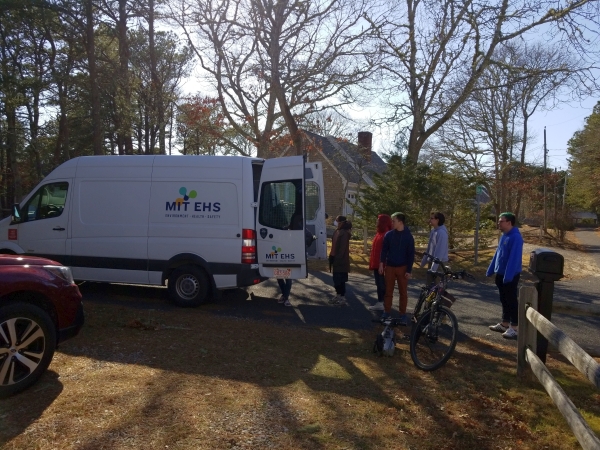 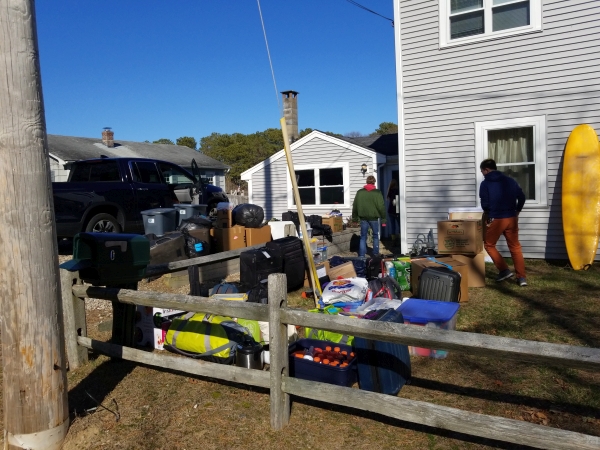 We
got to cape cod un-scathed, and proceeded to unload
everything onto the lawn so I could head back before the
sun evaporated away. There were many things, but also
many happy-to-have-found-a-home people. We
got to cape cod un-scathed, and proceeded to unload
everything onto the lawn so I could head back before the
sun evaporated away. There were many things, but also
many happy-to-have-found-a-home people. |
 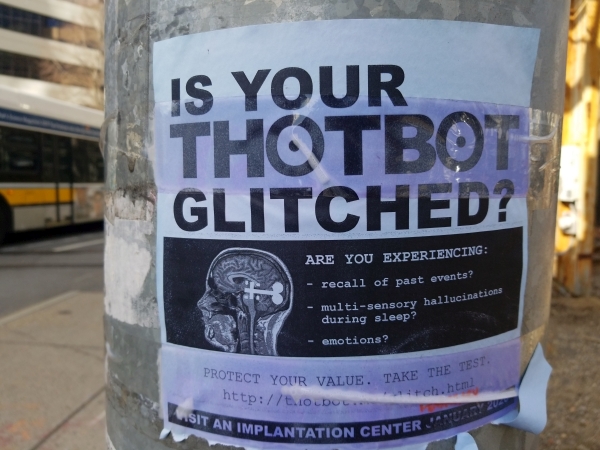 On the ride back I
stopped by a grocery store, mostly out of curiosity to
see if the panic had set in way out on the cape. It
was interesting, Milk, Bread and Yogurt were gone, but
everything else was there. I think I counted three
folks wearing face protection, I was wearing some
spare purple lab gloves and a mold-over vented N95.
Its Pi Day 2020. On the ride back I
stopped by a grocery store, mostly out of curiosity to
see if the panic had set in way out on the cape. It
was interesting, Milk, Bread and Yogurt were gone, but
everything else was there. I think I counted three
folks wearing face protection, I was wearing some
spare purple lab gloves and a mold-over vented N95.
Its Pi Day 2020. |
  Got back to Cambridge,
paid $20 for some diesel (This van hides the fuel door
behind the passenger door, which took a solid 5
minutes to find). I promptly returned the van to
its sleepy corner of campus. Wow I couldn't
believe that worked as well as it did, but it did. I
got back home, took a shower and proceeded to flomp. I
didn't do anything particularly strenuous, but for
whatever reason the anxiety of the unknown really
chews through energy efficiently. Got back to Cambridge,
paid $20 for some diesel (This van hides the fuel door
behind the passenger door, which took a solid 5
minutes to find). I promptly returned the van to
its sleepy corner of campus. Wow I couldn't
believe that worked as well as it did, but it did. I
got back home, took a shower and proceeded to flomp. I
didn't do anything particularly strenuous, but for
whatever reason the anxiety of the unknown really
chews through energy efficiently. |
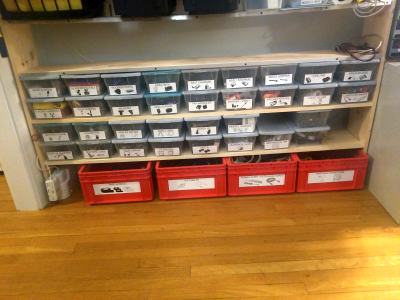 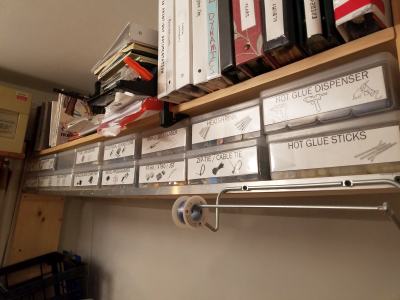 At home I was happy that
we got the moving done, kinda curious to see what the
subsequent weeks would be like. A return to normalcy,
or whatever that would be, and whenever it would
happen. I was admittedly anxious, I took precautions,
wearing gloves and a mask throughout the whole
trip but, information about how the plague spread was
not fantastically available. Spent the rest of the
following day cleaning and organizing the
miscellaneous home hardware. At home I was happy that
we got the moving done, kinda curious to see what the
subsequent weeks would be like. A return to normalcy,
or whatever that would be, and whenever it would
happen. I was admittedly anxious, I took precautions,
wearing gloves and a mask throughout the whole
trip but, information about how the plague spread was
not fantastically available. Spent the rest of the
following day cleaning and organizing the
miscellaneous home hardware. Gallery of images from the Cape Cod Excursion [link]. |
| A quick motor controller test and the final product |
| After the
modifications to their stock controller to get it to
operate at a lower battery voltage, I recorded a quick
video clip showing the simple functionality. |
| A few weeks later the following wonderful
machine was born: Great job guys! More details of their build are here: |
| "Drive In Movie Night" |
 Advert for the evening shown right. |
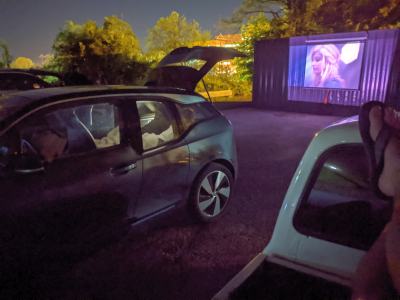 |
| Hiking and exercise |
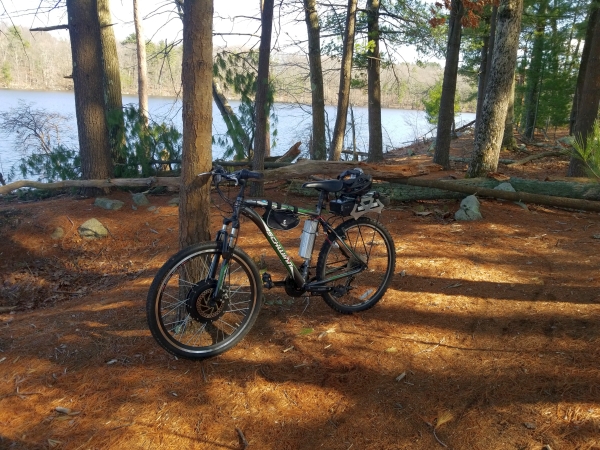 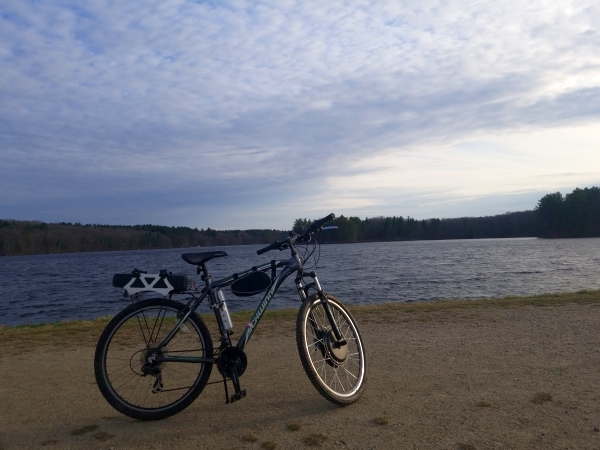 After a few weeks of
working remotley, loosing track of time and being a
bit wound up I tried a 'work from home but outdoors'
day. Its late March, undergrads were all kicked out a
week and a half ago. Its still cold, and everything is
uncertain in the aether. I hopped on my derpy
home 'mountainbike' ebike, which is admittedly less
used than the roadbike or the newer mountain ebike,
but it works. I brought along with me a folding chair
and a backpack of snacks. After a few weeks of
working remotley, loosing track of time and being a
bit wound up I tried a 'work from home but outdoors'
day. Its late March, undergrads were all kicked out a
week and a half ago. Its still cold, and everything is
uncertain in the aether. I hopped on my derpy
home 'mountainbike' ebike, which is admittedly less
used than the roadbike or the newer mountain ebike,
but it works. I brought along with me a folding chair
and a backpack of snacks. I live outside of the city, aside of some dog walkers, its fairy quiet. The first voyage out to do some exploring happened in late March. I had been home and abiding by the keep away from everyone rule, but given the remote-ness of my locale, some exploring with PPE persued. |
  Exploring
local areas Exploring
local areasThe park and nearby woodlands are always a treat. This spot in particular is a favorite as it looks out onto the resivour with a farily open view. In early april there's not enough thermal energy outdoors for the flies and mosquitoes to awaken so its a fairly excellent experience overall. |
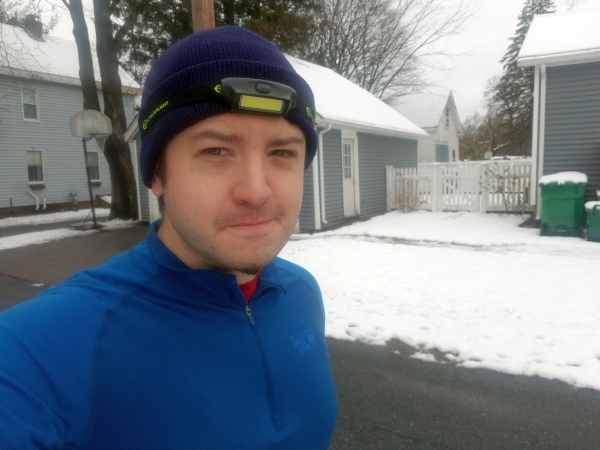 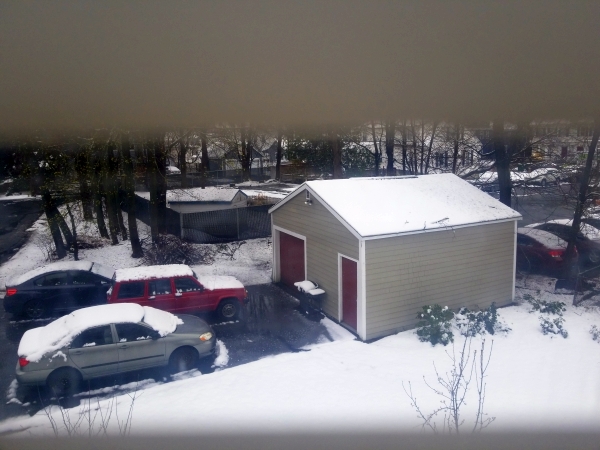 Mid April brought some
late snow. For whatever reason I enjoy running in bad
weather. It was impressivley silent out on that snowy
quarantined morning. Its unfortunate my robot
snowblower was hiding near the city, so shoveling here
was a manual exercise. Mid April brought some
late snow. For whatever reason I enjoy running in bad
weather. It was impressivley silent out on that snowy
quarantined morning. Its unfortunate my robot
snowblower was hiding near the city, so shoveling here
was a manual exercise. |
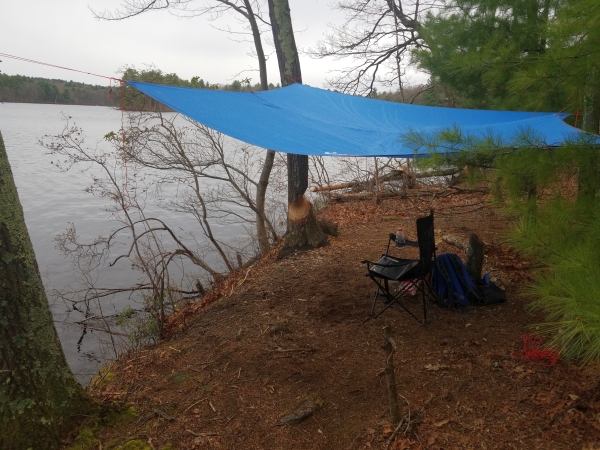 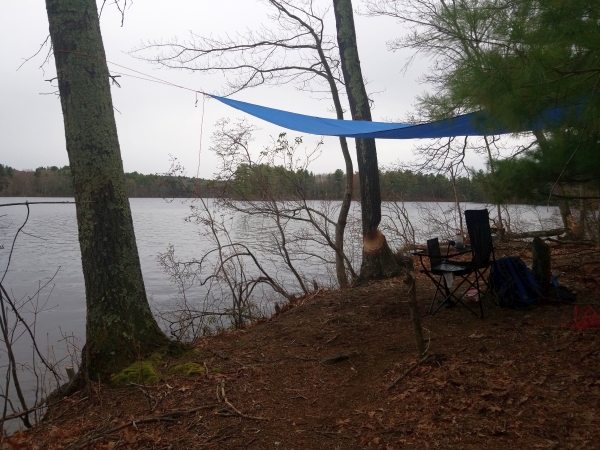 A
first attempt at work from home, outdoors edition. A
first attempt at work from home, outdoors edition.It was late April so things were still cold outside I had a 10' x 10' ish tarp and rope, and was tired of being cooped up in an apartment so i ventured out and made an impromptu remote office. I dragged along a camping chair, |
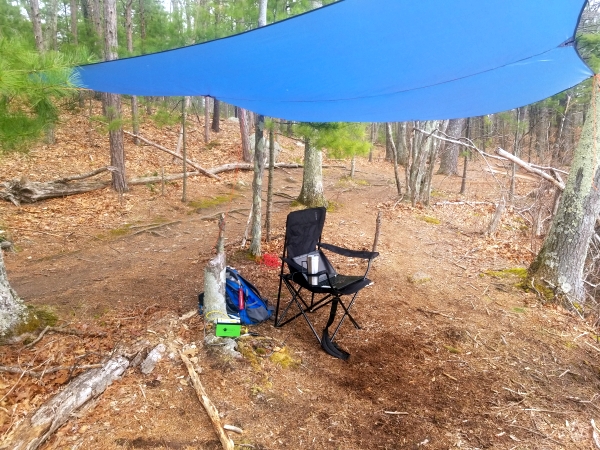 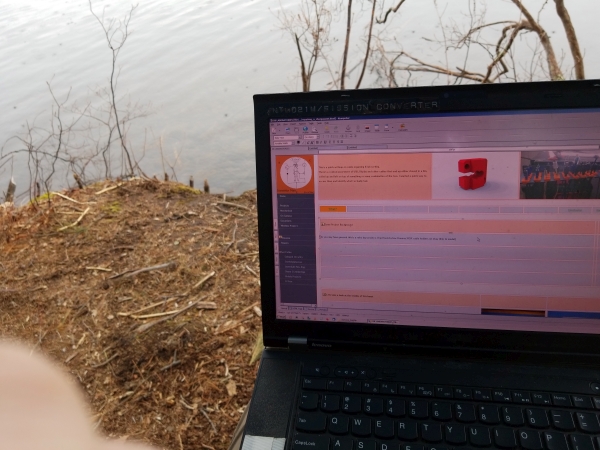 I had along with me a 12v
thermos and a small 12v LiFePO4 battery module. This
provided some hot water for tea. The spot was
alongside an out-of-the way trail and a few dog
walkers said hi. After around an hour it began
raining. Interestingly folding camping chairs do
little to keep your bottom from freezing off. I had along with me a 12v
thermos and a small 12v LiFePO4 battery module. This
provided some hot water for tea. The spot was
alongside an out-of-the way trail and a few dog
walkers said hi. After around an hour it began
raining. Interestingly folding camping chairs do
little to keep your bottom from freezing off. |
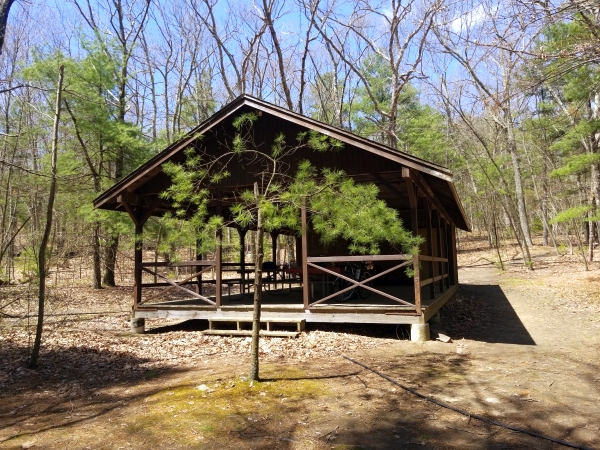 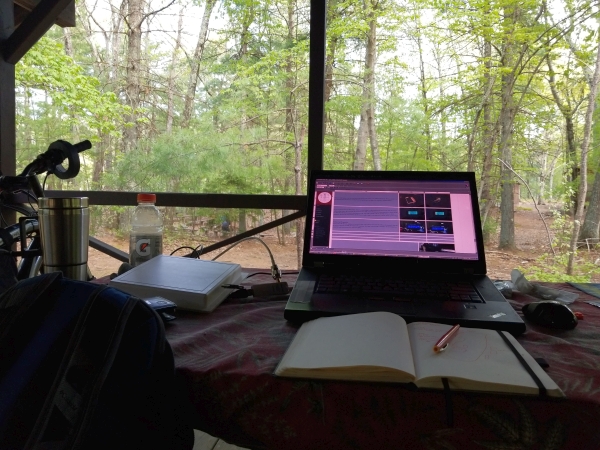 I
later found some more interesting work from home, albiet
outdoors spots. I
later found some more interesting work from home, albiet
outdoors spots. There was a really interesting pavilion hiding as a remnant from some depreciated campsite. It had two large picnic benches and a surprisingly non-leaky roof. This was way better than my dodgey folding chair and a tarp. |
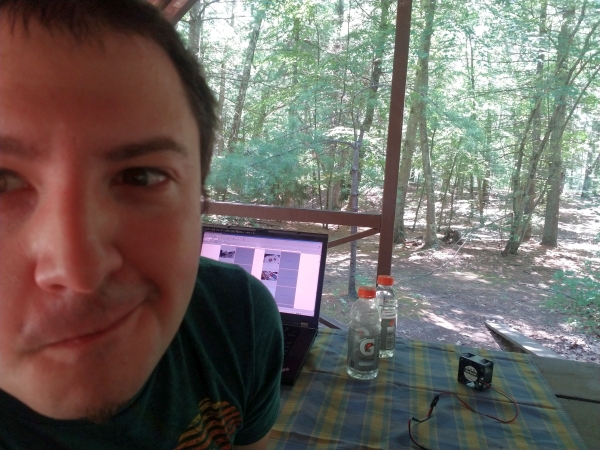  Work
from home outdoors tips and tricks: Work
from home outdoors tips and tricks:I found that some simple things to bring along make a big difference. A small cloth tablecloth, a few snacks, handwipes and a 12v thermos to make some tea made the outdoors productive. Later on I brought along a modified greenworks '40v' 300w inverter, which makes an excellent e-bike -> 110vac converter. I also dragged along a small 'desk fan' for those warm days. The view from my 'desk' was quite excellent. This was a great escape. |
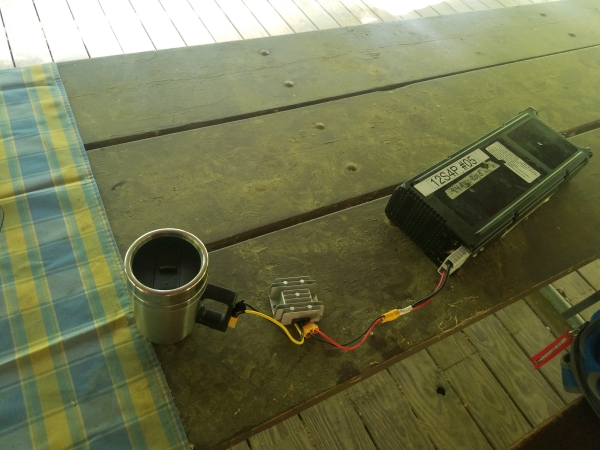 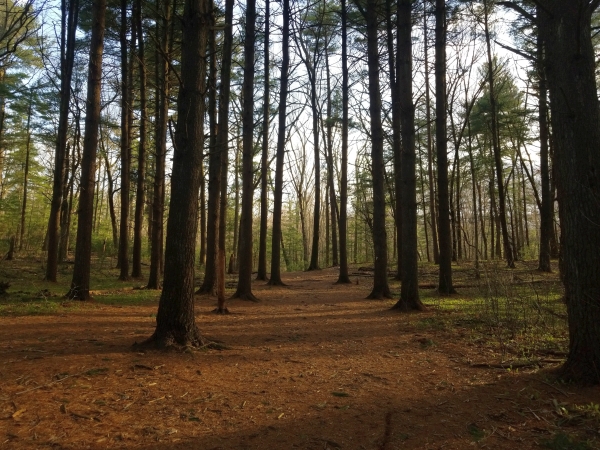 The nearby park was a really excellent
reprieve from the world. Tea and outdoors is a good
mix. Shown far right was a hastily thrown together
36v battery pack -> 12v thermos adapter. The nearby park was a really excellent
reprieve from the world. Tea and outdoors is a good
mix. Shown far right was a hastily thrown together
36v battery pack -> 12v thermos adapter. |
| 360 Video Adventures |
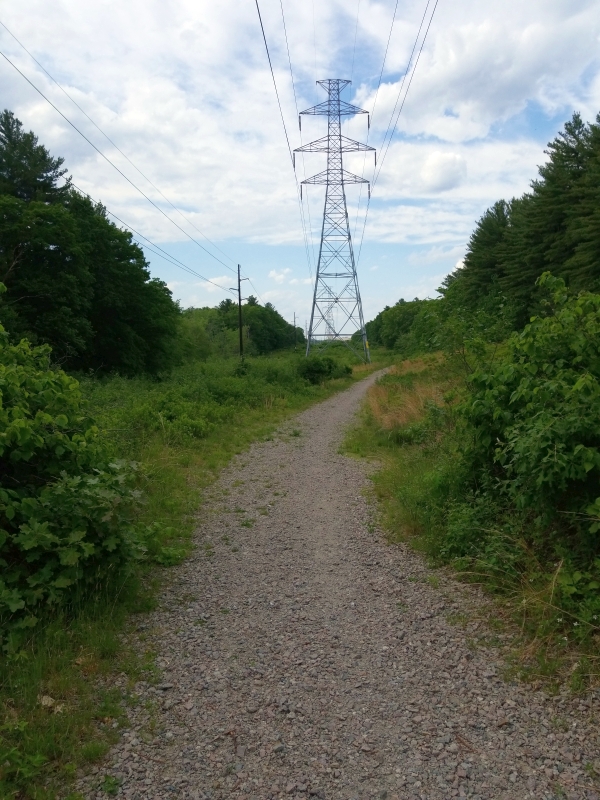 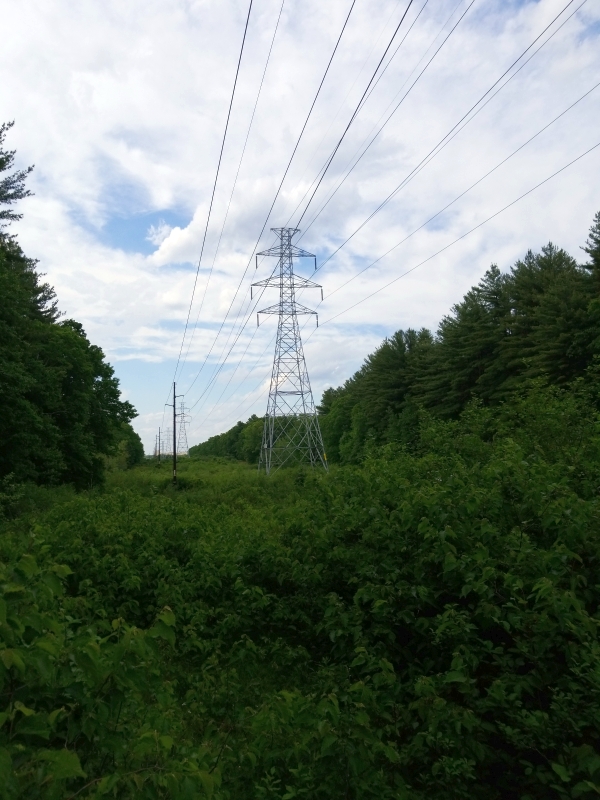 I had this idea, where I
wear a 360 video camera and go do some longer trek
mountain-biking / exploring. Seems simple right, put
camera on head go biking right? As it turns out the
GoPro 360 that I used was a peculiar beast, the fusion
360 is an earlier variant, which opted to do all its
meshing off-board. The process for going from footage
to embed-able video is fairly cumbersome. I documented
some of the trials and tribulations here: I had this idea, where I
wear a 360 video camera and go do some longer trek
mountain-biking / exploring. Seems simple right, put
camera on head go biking right? As it turns out the
GoPro 360 that I used was a peculiar beast, the fusion
360 is an earlier variant, which opted to do all its
meshing off-board. The process for going from footage
to embed-able video is fairly cumbersome. I documented
some of the trials and tribulations here: |
| MIT Reopening Round 1 |
| Getting researchers back in |
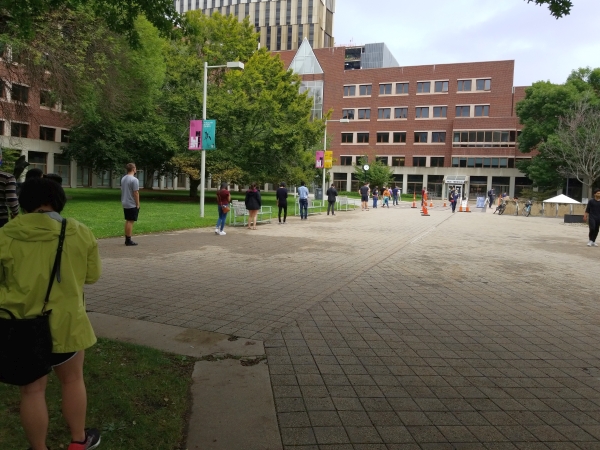 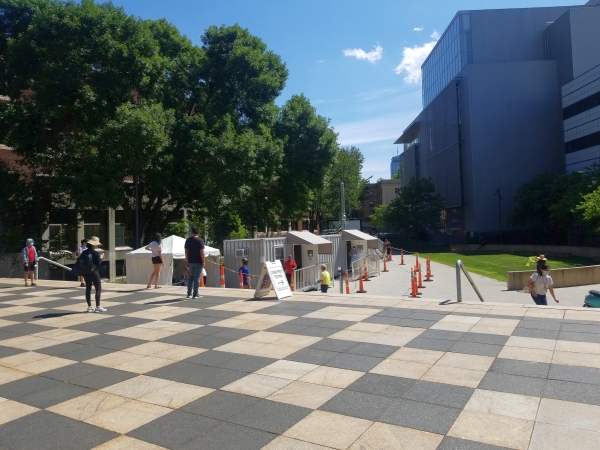 Getting
tested twice weekly Getting
tested twice weekly |
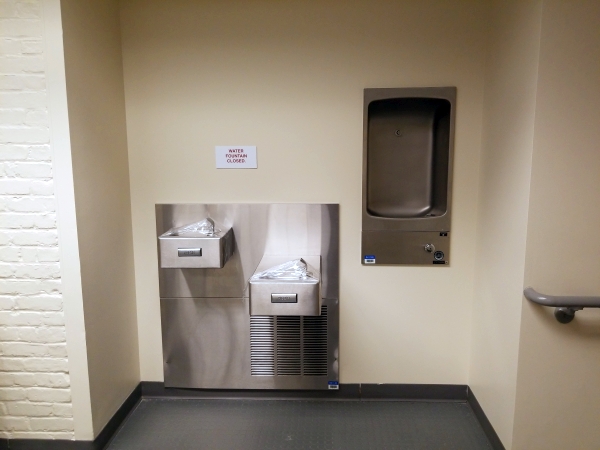 Some
interesting observations while on campus during this
time Some
interesting observations while on campus during this
timeDisabling communal devices water fountains and water coolers are either turned around to discourage use or wrapped over / spouts removed. |
| Hardware installation & shipping logistics. |
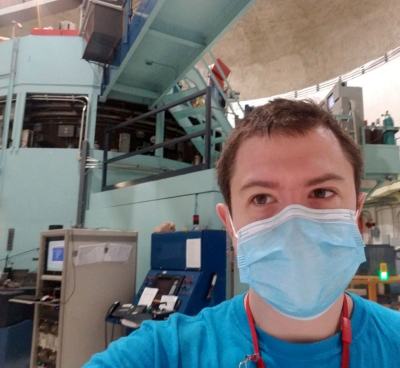 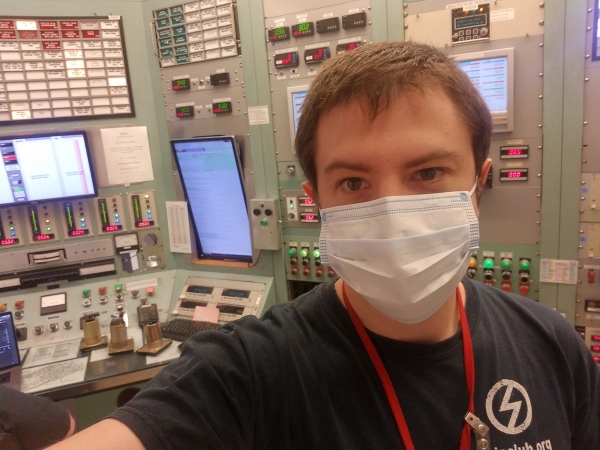 Lets start with some
back-story. Some time in 2014 the hardware for an
upgraded controls system for the MIT NRL was submitted
to the NRC. fast forward to late 2019 and it was approved. Here's
the submission in all its photocopied-pdf glory:
[link] Lets start with some
back-story. Some time in 2014 the hardware for an
upgraded controls system for the MIT NRL was submitted
to the NRC. fast forward to late 2019 and it was approved. Here's
the submission in all its photocopied-pdf glory:
[link]Interestingly there's a timeline embedded into the installation, 180 days. This is probably to ensure that approved upgrades happen in a reasonable timeline but its not terribly clear. Unfortunately that 180 day window started right around when Wuhan was experiencing the beginning of the pandemic. An extension was granted, but upgrade season had begun! |
  What
is being research staff at MIT like during this time? What
is being research staff at MIT like during this time?The return to research was broken into three phases, the first of which had little guidance on Covid testing intervals. I opted to go at least weekly, but the testing interval wasn't well defined for phase 1. Building access was restricted to only the building you absolutely need. By this period the personnel who were on-campus residents had a once weekly requirement. During research ramp-up phase 1, MIT medical had its hands full, trailers were setup for testing, and the actual 'get tested' process changed a bit over the phase 1 / rampup. |
| Getting a covid test process part 1: |
| Getting a covid test process part 2: |
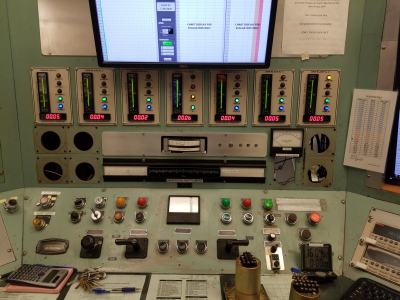 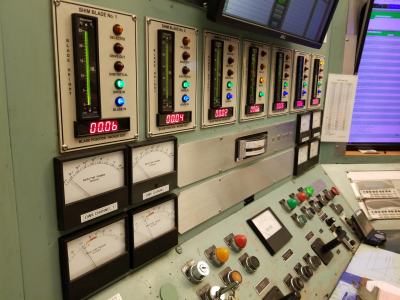 This process involved
removing a bunch of legacy hardware, identifying
abandoned cable runs, removing things, documenting,
labeling, cabling and the like. Realistically this
compounded by issues of hardware abandonment, when
items were removed from service its nominally less
intrusive to simply leave that hardware /
cabling in place, instead of removing.
Integrating that practice over decades resulted
in a lot of abandoned things. Documenting and removing
those things were laborious
to say the least. This process involved
removing a bunch of legacy hardware, identifying
abandoned cable runs, removing things, documenting,
labeling, cabling and the like. Realistically this
compounded by issues of hardware abandonment, when
items were removed from service its nominally less
intrusive to simply leave that hardware /
cabling in place, instead of removing.
Integrating that practice over decades resulted
in a lot of abandoned things. Documenting and removing
those things were laborious
to say the least. |
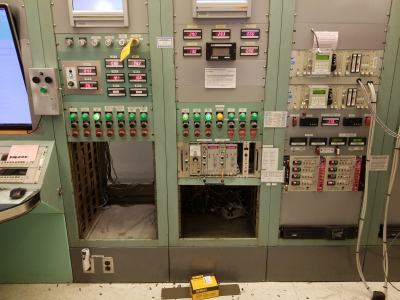 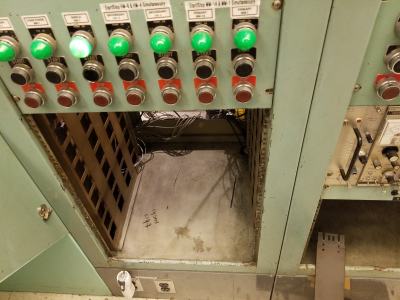 Interesting
artifacts Interesting
artifactsWhile removing some ancient pico-ammeters, way on the bottom of a rack cabinet there was scribbled "This Sucks" with some very vintage grease pencil. Clearly the last installation had its trials and tribulations. I added a new sticker for whoever ends up doing this process again in the distant future. |
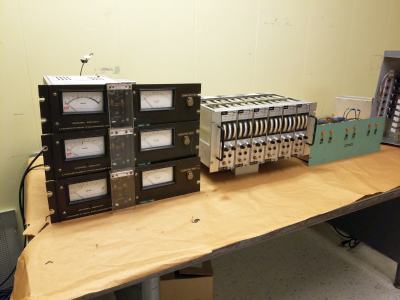 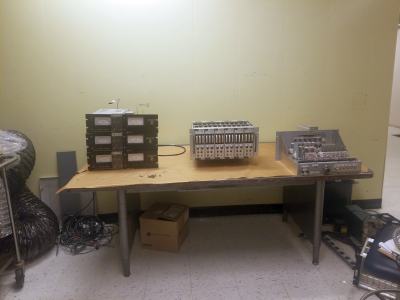 Legacy
instruments that were removed ended up piling out on a
table outside of the control room. Legacy
instruments that were removed ended up piling out on a
table outside of the control room. Slowly it grew to a bit of a cacophony of elderly technology and miscellaneous gray wires. |
| Oh how i missed the hobby-jet |
| MIT
Campus Testing Round 2: |
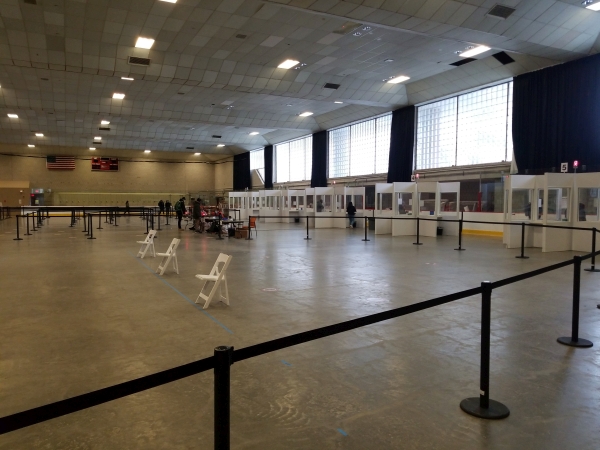 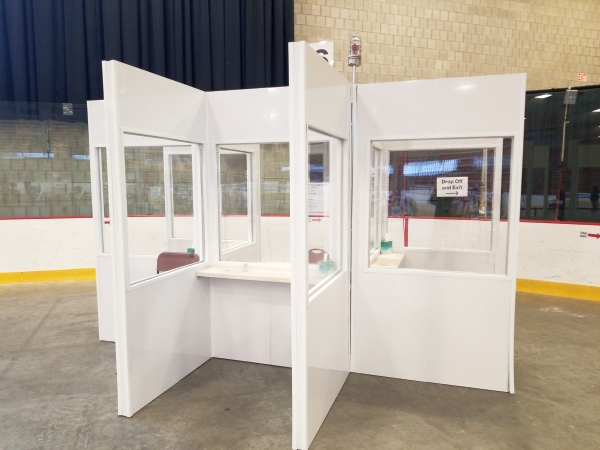 Testing opened up at the Johnson
Athletic center, this was all indoors, as the 'stand
around outside by MIT medical' wouldn't work so well
during the winter. The setup worked surprisingly well,
there were 3 spots for folks to scan your id / phone-app
bar-code, when you scanned in they would see a photo of
your face, you confirmed your phone & DOB, then were
given a sampling container. You'd head to these weird
3-person stations where someone would observe you picking
your nose. Testing opened up at the Johnson
Athletic center, this was all indoors, as the 'stand
around outside by MIT medical' wouldn't work so well
during the winter. The setup worked surprisingly well,
there were 3 spots for folks to scan your id / phone-app
bar-code, when you scanned in they would see a photo of
your face, you confirmed your phone & DOB, then were
given a sampling container. You'd head to these weird
3-person stations where someone would observe you picking
your nose. This was way more labor intensive than Harvard's approach. Harvard offered little baggies with bar-codes and sampling container. You could grab a few before hand, when you needed to provide a sample you do it and drop it off. Maybe Harvard trusts folks to not putz with having other folks submit tests on other peoples behalf, or maybe it was just cheaper. |
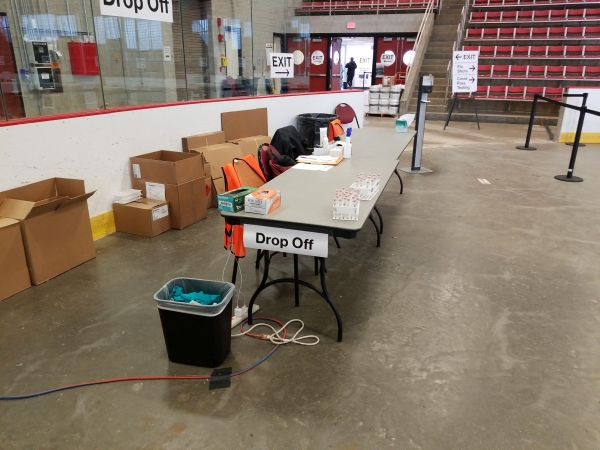 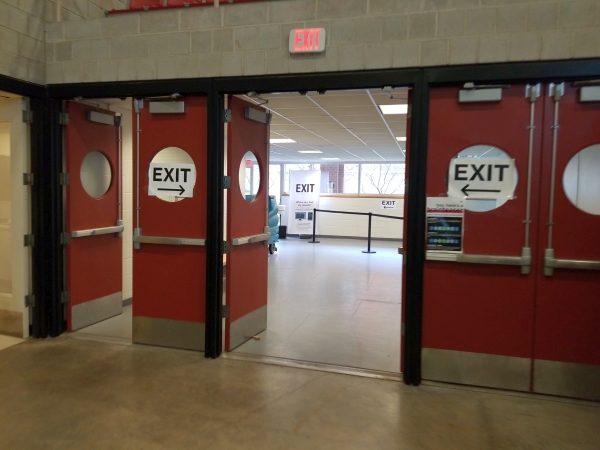 You take your little sample container
(with associated bar-code) to a drop off desk, where they
get loaded into trays and sent down to the BROAD
institute, a few blocks away. You take your little sample container
(with associated bar-code) to a drop off desk, where they
get loaded into trays and sent down to the BROAD
institute, a few blocks away. |
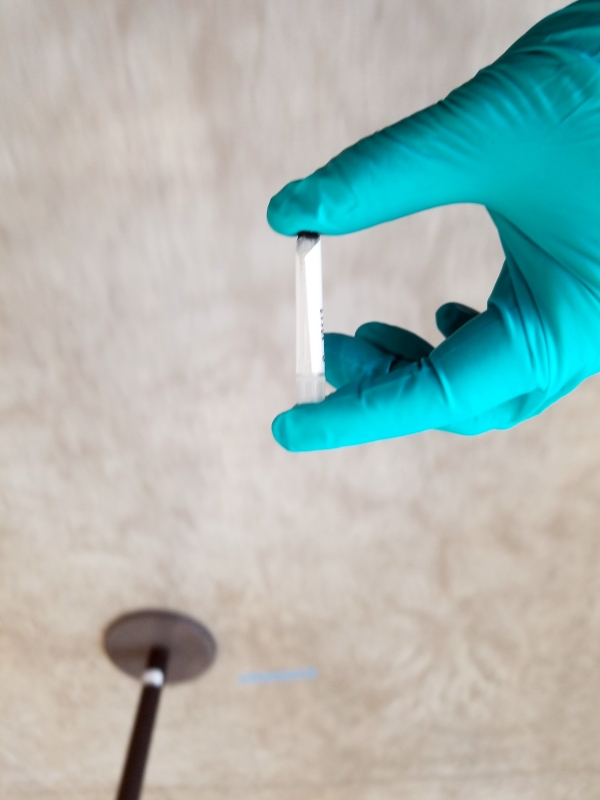 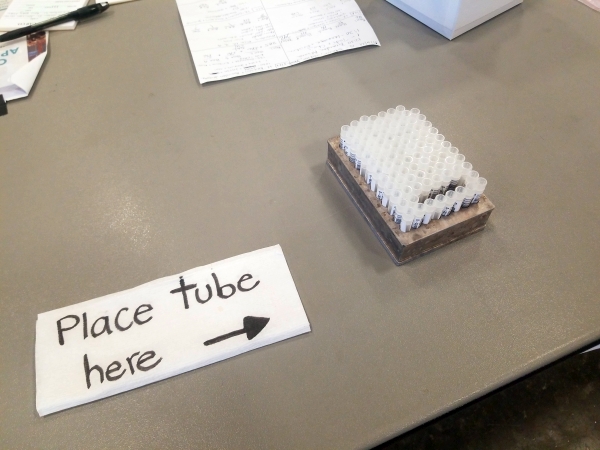 Testing Continued: Testing Continued:The testing process ended up with small trays. These appeared to be a stainless block that was cnc'd with slightly oversized holes to fit everyone's testing samples. I imagine these were grabbed by a pick and place for faster analysis. |
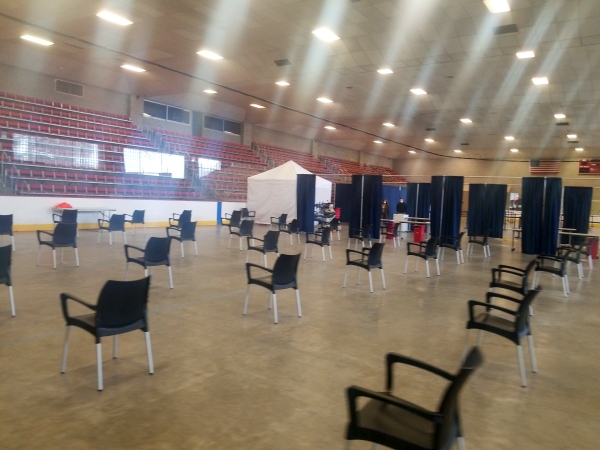  Vaccinations @ MIT: Vaccinations @ MIT:At risk Faculty & Staff were offered vaccinations fairly early, but this was limited to MIT Medical staff & rather older folk. Around January 2021, MIT started getting excited about vaccinating more of its personnel, and setup booths and chairs for doing large group vaccinations. This was exciting as it was a bit of light at the end of the tunnel. But alas, like most things, it did not pan out. Massachusetts leaned heavy on having the state be the sole distributor of vaccine. To complicate things, northeastern demonstrated it was unable to play fair [link], and mildly screwed it up for the rest of nearby academia. MIT ended up getting small amounts of vaccine in early May 2021, but were unable to guarantee second-shots. In the meantime updates to signage and new processes for keeping case numbers down continued along. |
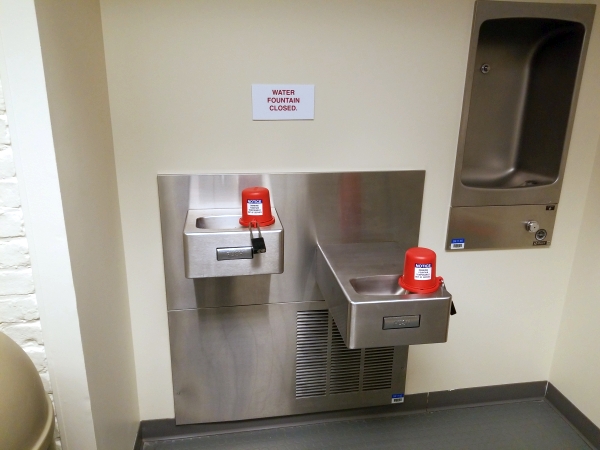 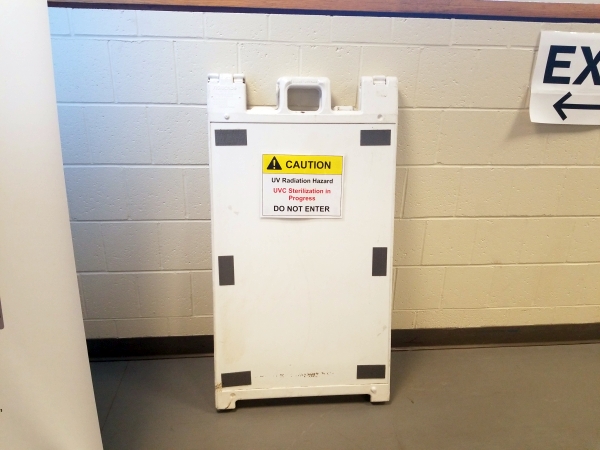 Speaking of signage changes: Speaking of signage changes:There was a modified tele-presence robot equipped with UVC bulbs that got a dock station over in the Athletic center. I'm not sure if it was used frequently or not, but the signage was interesting. Water-fountains now had industrial lockout tag-out applied to prevent use and other oddities were added, sporadically around campus. |
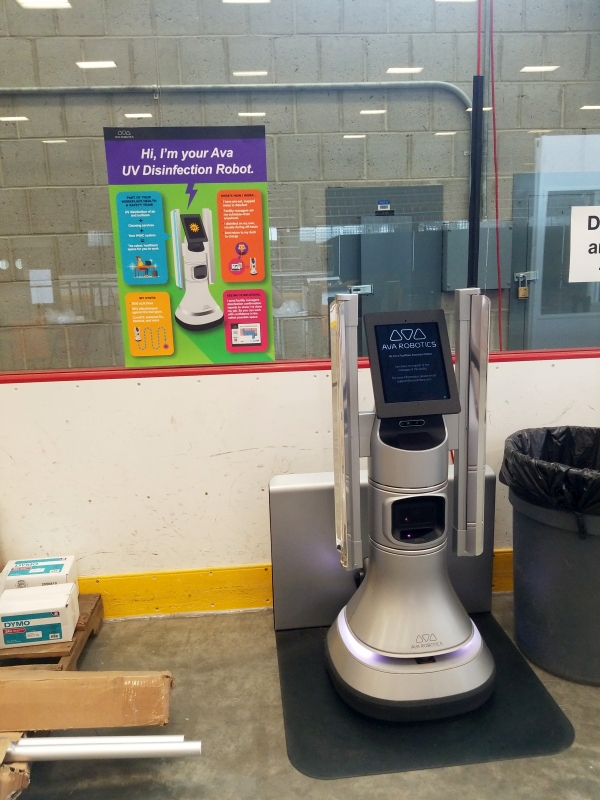 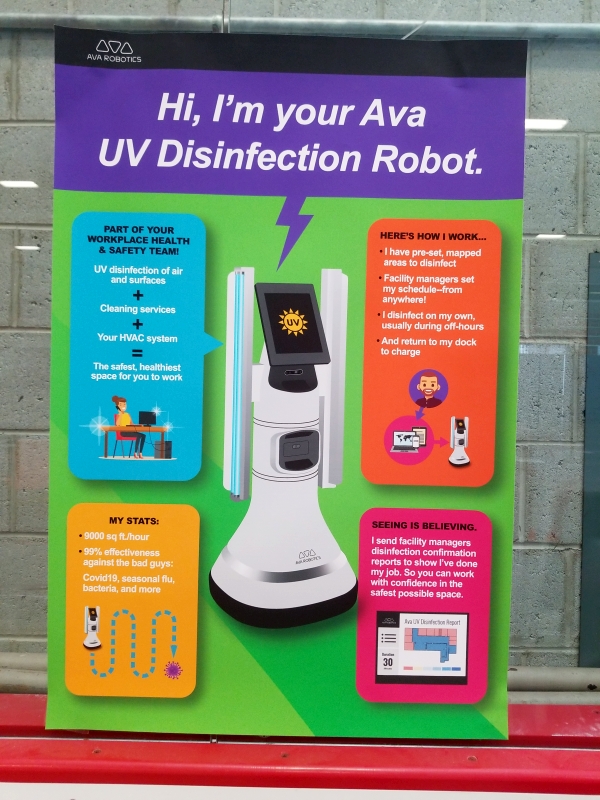 Here's the lil fella, now with some
updated documentation. This contraption is by Ava Robotics, a
telepresence company in Cambridge MA. They have some
details about their disinfection robot here [link]. Here's the lil fella, now with some
updated documentation. This contraption is by Ava Robotics, a
telepresence company in Cambridge MA. They have some
details about their disinfection robot here [link].There's a pamphlet here [link] and a local copy [link] The Ava disinfection bot was parked in the MIT field-house / ice rink where bulk testing was performed. It always was on its charger pad, but that is likely due to it operating only when people were not around. |
A
24-Hour IHOP, but for plague testing 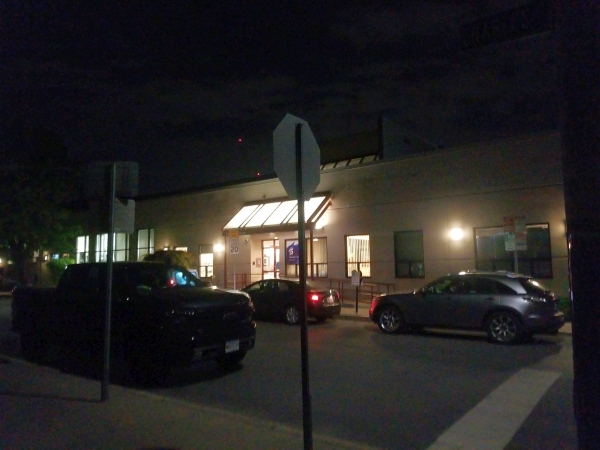 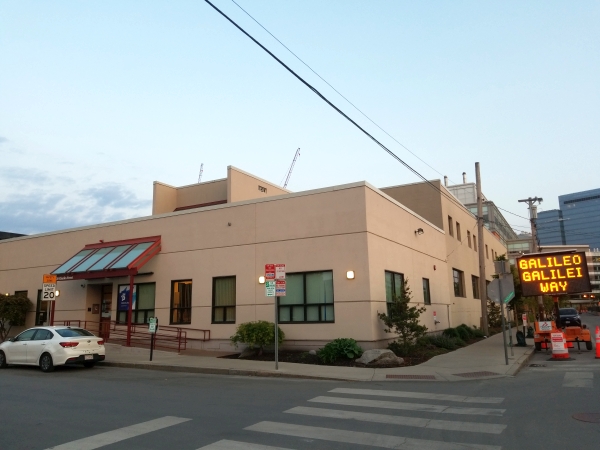 Almost all of the little adorable vials from Cambridge and nearby areas ended up here, you could walk by at night and see the small x-y pick and places or some lab technician staring at a vertically mounted screen. This is Broad Institute 320C [link]. Note you couldn't stop by to get tested, but most of the surrounding tests were PCR'd right in that small building. During the day, small school buses would appear, miscellaneous cars would appear all dropping off tiny coolers with bio-hazard stickers of (likely) testing vials. |
| Ghost
Town |
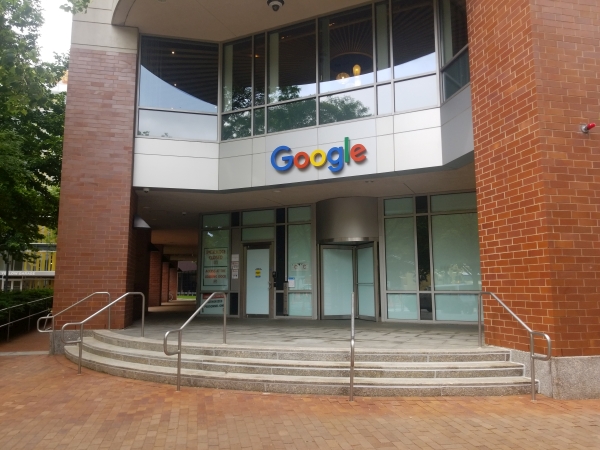 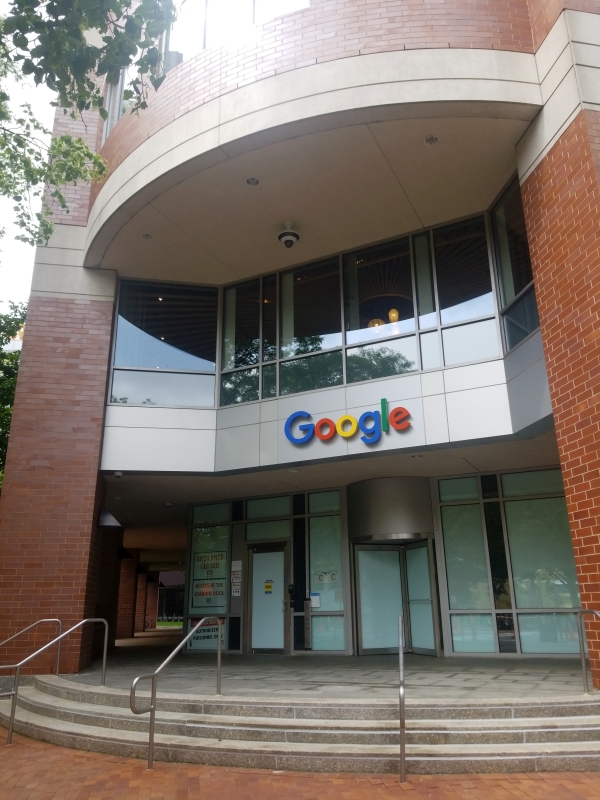 I did get a chance to take some
photos of places that were normally busy but immediately
switched to being boarded up. This is the google Cambridge
campus, right in the Kendal square area. During normal
times this was a bit better lit and had folks flooding in
and out, especially during noontime. I did get a chance to take some
photos of places that were normally busy but immediately
switched to being boarded up. This is the google Cambridge
campus, right in the Kendal square area. During normal
times this was a bit better lit and had folks flooding in
and out, especially during noontime. |
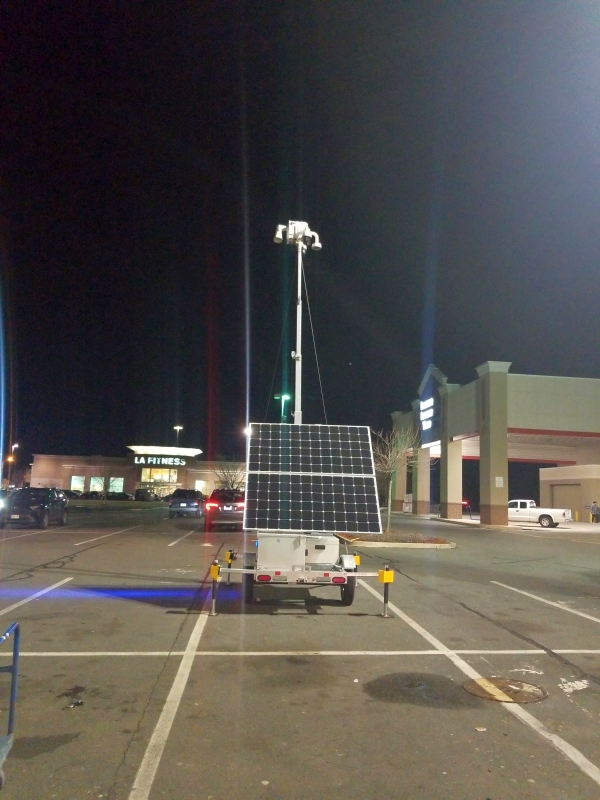 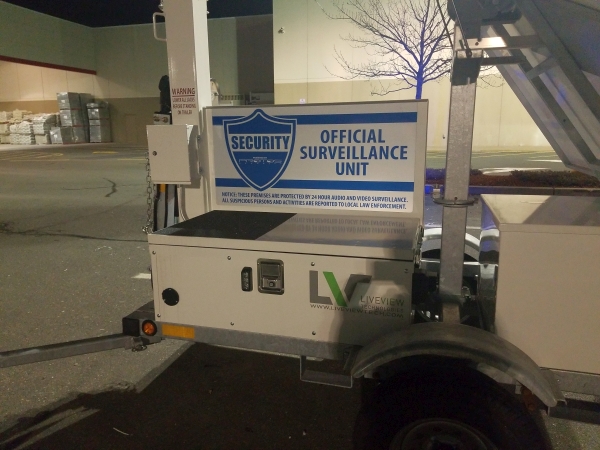 Found this odd contraption out
waiting for curbside pickup, it appeared to be a solar
powered 4g connected snitch? its really not clear what it
was doing next to the Lowes parking lot, maybe an method
to reduce pd personnel from being around other people? It
was fairly creepy. Found this odd contraption out
waiting for curbside pickup, it appeared to be a solar
powered 4g connected snitch? its really not clear what it
was doing next to the Lowes parking lot, maybe an method
to reduce pd personnel from being around other people? It
was fairly creepy. |
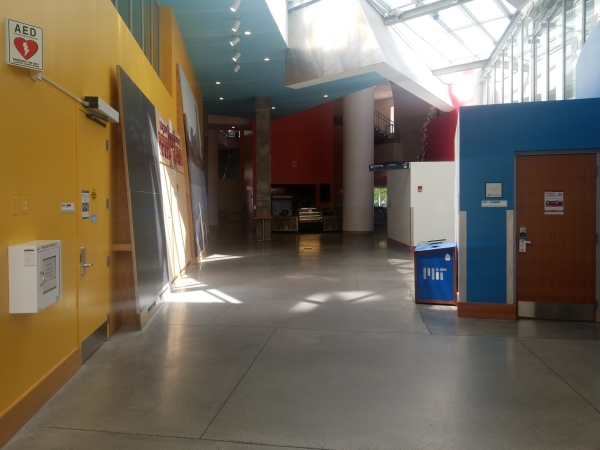 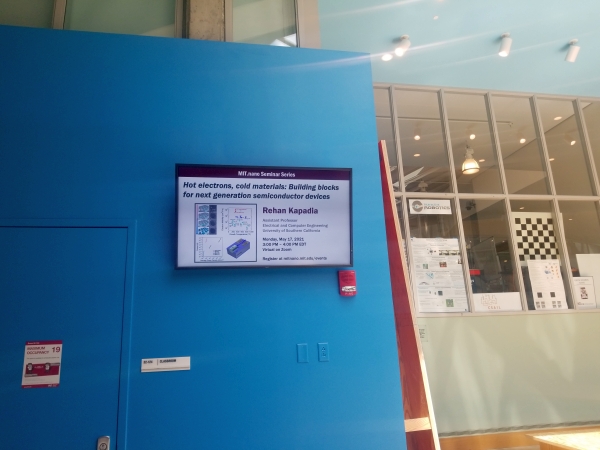 MIT's Stata center on a weekday. It
was a ghost-town. The wall displays were still up but
there was no one to see them. The lunch area being dark
during the mid-day was just plain weird. MIT's Stata center on a weekday. It
was a ghost-town. The wall displays were still up but
there was no one to see them. The lunch area being dark
during the mid-day was just plain weird. |
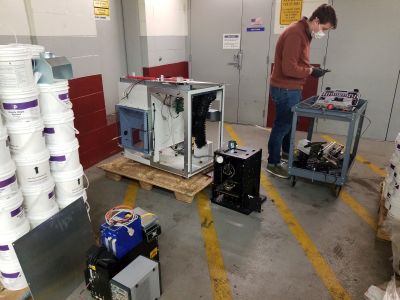 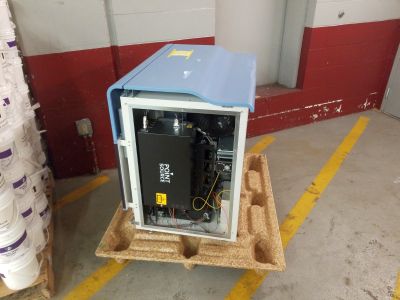 Attempting to dumpster dive during a
pandemic went a bit weird. The Excellent Austin [link]
spotted a genome sequencer in the Stata loading docks.
They had been locked up for somewhat confusing reasons,
but after a half dozen emails i was able to get access to
the sequencer and begin tear-down. I was met by another
cruft hunter and we kinda carefully took the thing to
bits, he had a wonderful collection of tools handy which
made the process way easier. Attempting to dumpster dive during a
pandemic went a bit weird. The Excellent Austin [link]
spotted a genome sequencer in the Stata loading docks.
They had been locked up for somewhat confusing reasons,
but after a half dozen emails i was able to get access to
the sequencer and begin tear-down. I was met by another
cruft hunter and we kinda carefully took the thing to
bits, he had a wonderful collection of tools handy which
made the process way easier. |
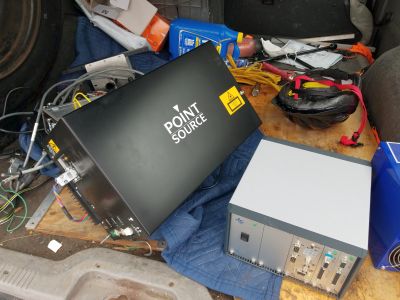 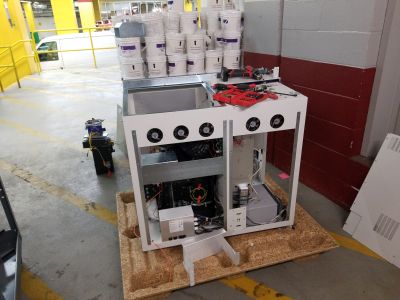 My prize was the camera, almost all
of this generation contraption have a fairly fancy chilled
monochrome camera inside. I was surprised to find a lot of
other interesting kit, a small solid state chiller, a
laser light source, linear stages, it was amazing. My prize was the camera, almost all
of this generation contraption have a fairly fancy chilled
monochrome camera inside. I was surprised to find a lot of
other interesting kit, a small solid state chiller, a
laser light source, linear stages, it was amazing. |
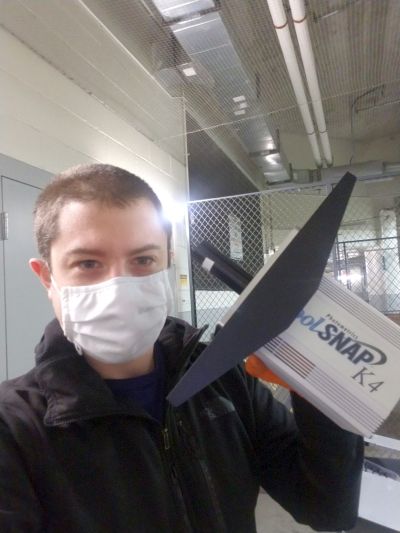 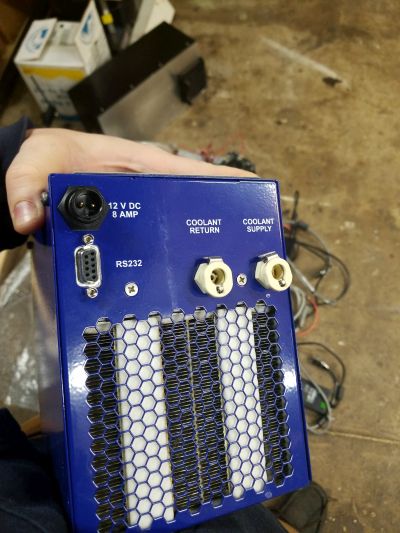 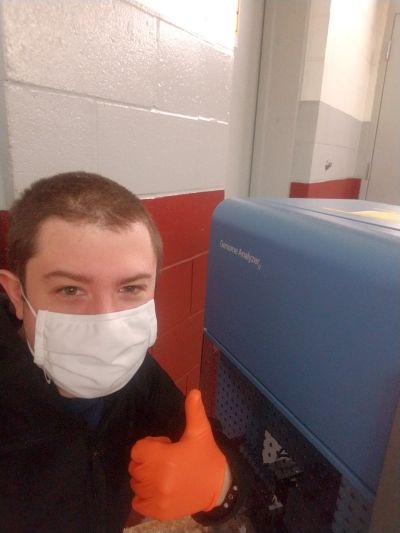 My prize extracted, a coolsnap K4 4MP
camera [datasheet]
Unfortunately the control computer was awol, so the
somewhat rare pci card to talk to it is going to have to
be an ebay hunt. The chiller ended up getting used on one
of the projects with some UROP students on determining the
efficacy of thermo-electric power harvesting for low delta
rx output. My prize extracted, a coolsnap K4 4MP
camera [datasheet]
Unfortunately the control computer was awol, so the
somewhat rare pci card to talk to it is going to have to
be an ebay hunt. The chiller ended up getting used on one
of the projects with some UROP students on determining the
efficacy of thermo-electric power harvesting for low delta
rx output. |
Some
visible supply-chain effects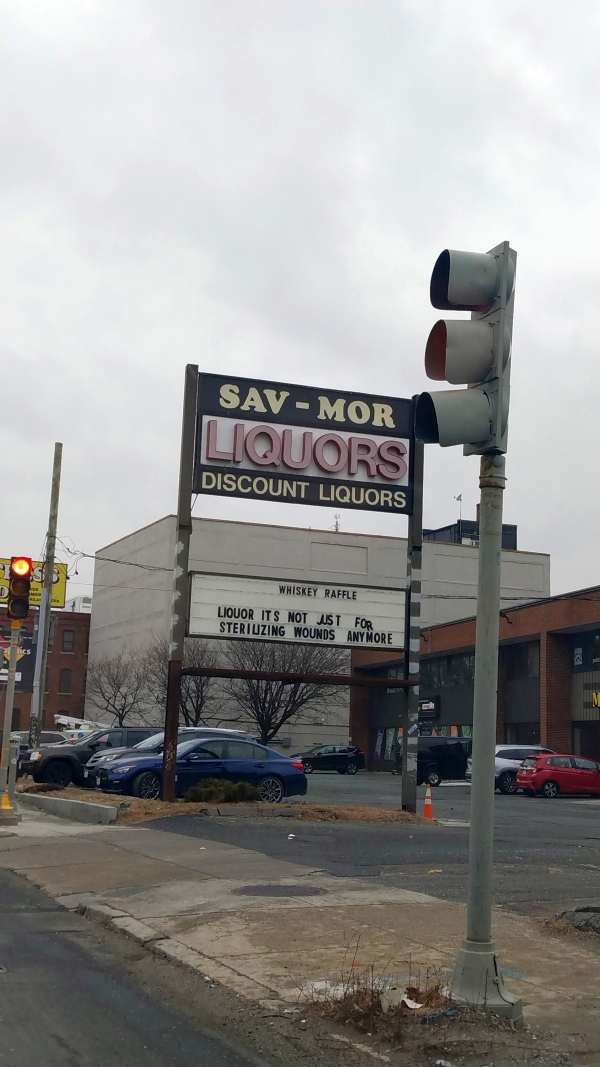 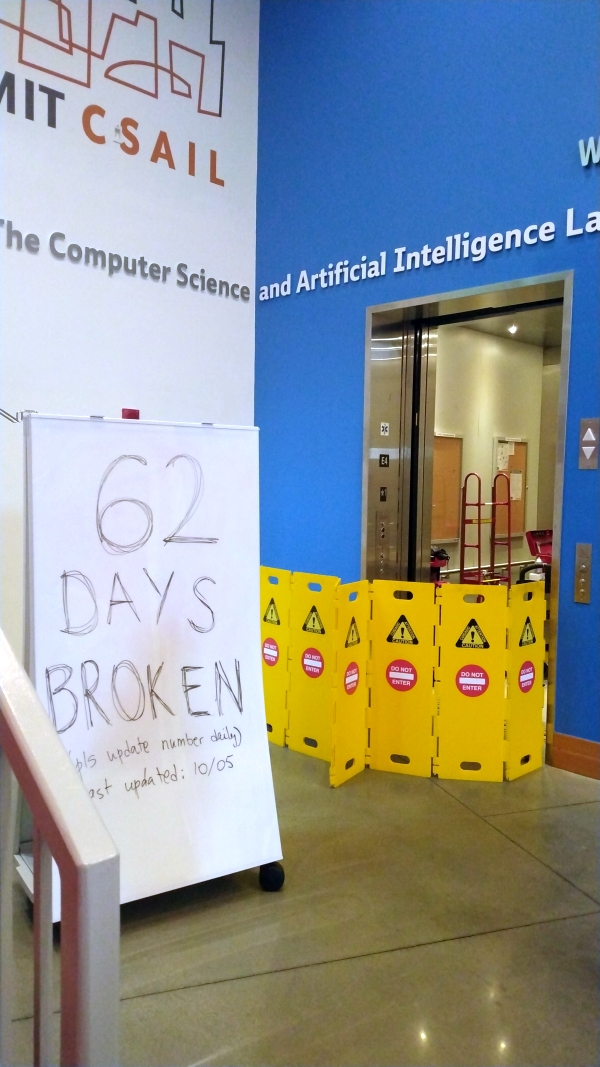 There were a few remnants of the length of the plague, the MIT Stata center elevator was down for ages, either due to parts shortages or the like. Finally a large whiteboard was rolled over to help 'motivate' its repair. I think it got repaired after 132 days of being reported. Early on in the pandemic, isopropyl alcohol and ethanol were fairly scarce. Sav-Mor liquors in Somerville managed to keep some humor going, but it was kinda curious what things experienced shortages and when during the pandemic. |
At home
test kits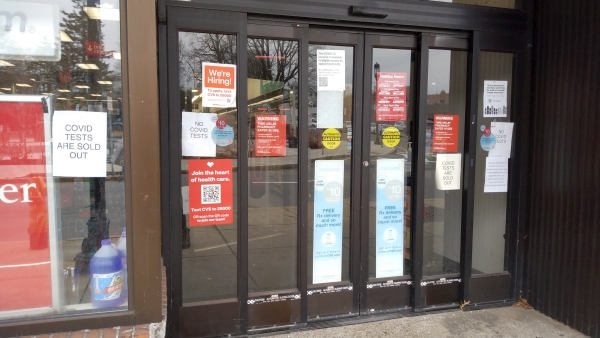 Fast forward to late 2021 its approaching the peak of the holiday season and one of the hot items to get are rapid tests. These are disposable antigen based tests which are somewhat useful, somewhat accurate but really handy. Given that it's now calendar year 2 of the pandemic the 2021 winter holiday was a bit more active than the 2020 winter holiday. With more people traveling the home test kits were a somewhat useful, quick way of determining if that person who was visiting was radiating plague. Comically all of these were out of stock completely surrounding the holidays. |
| Free test
kits for home, 2 months late While it would have been great if plotting occurred before hand and these were shipped out pre-holiday, the federal government stepped up to provide 4x test kits / household, likely to arrive in March 2022. USPS's main website was used as the request test kits mechanism, which was actually really smart. What impressed me the most was on launch day (when test kit requests became available) the overwhelming response somehow didn't destroy the USPS main site immediately. The website was https://special.usps.com/testkits to order test kits. Interestingly there's a ycombinator thread that somewhat digs into the behind the scenes [link] |
| Dane
Gets Lost in Astro-Photography |
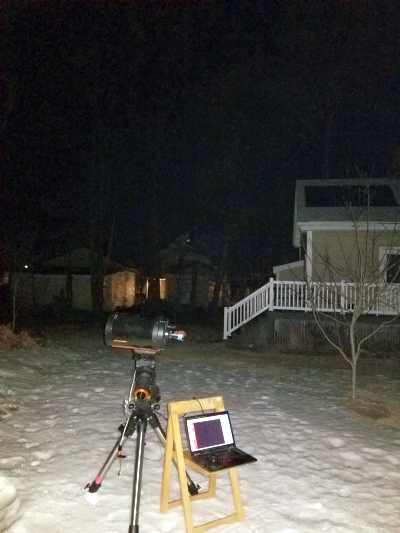 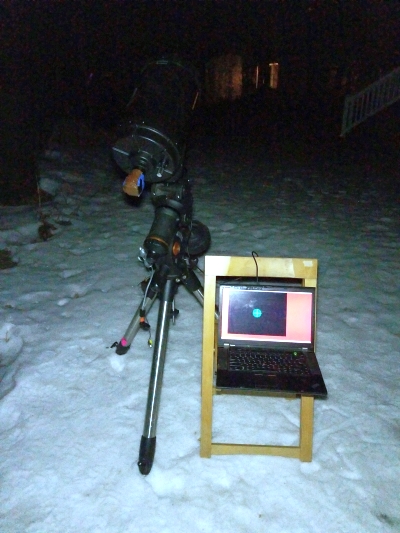 The ever-excellent Bayley Wang
grabbed a Celestron CGEM-8 ages ago, and due to the chaos
surrounding the time when MIT closed, it was stuck in
MITERS for a while. Thanks to some help from DLAB
Jack, I was able to borrow it for a bit. The ever-excellent Bayley Wang
grabbed a Celestron CGEM-8 ages ago, and due to the chaos
surrounding the time when MIT closed, it was stuck in
MITERS for a while. Thanks to some help from DLAB
Jack, I was able to borrow it for a bit. Did you know Astro-photography is very similar hobby to small arms collection? You cant just have a telescope, it needs a sight, an aiming camera, a tracking mount, a pile of widgets and filters. Batteries, band heaters a laptop, the list goes on and on. So what did I end up trying out? Good Question |
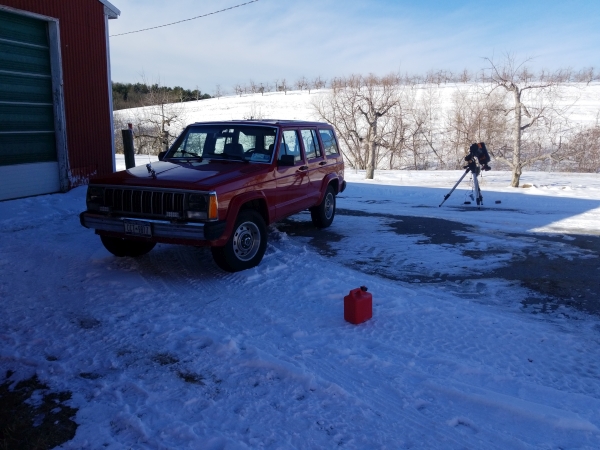 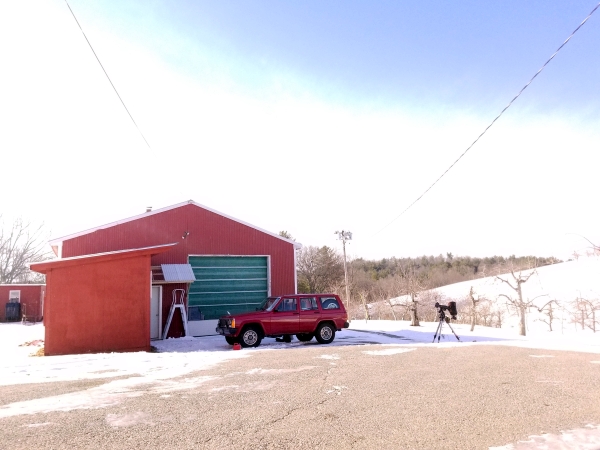 I managed to find some dark skies
thanks to the nice folks at Autumn Hills Orchards, mid
winter, clear skies and quite cold. It was
wonderful. I managed to find some dark skies
thanks to the nice folks at Autumn Hills Orchards, mid
winter, clear skies and quite cold. It was
wonderful. To not freeze into a solid block, I repaired / revived a diesel heater, documented here [yeet heet]. I piped the hot air into the jeep and stayed surprisingly warm overnight. |
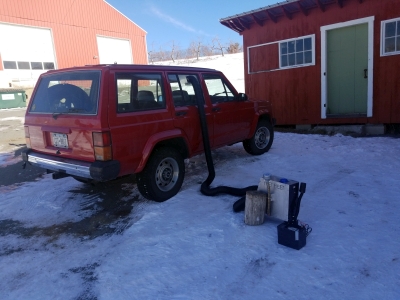 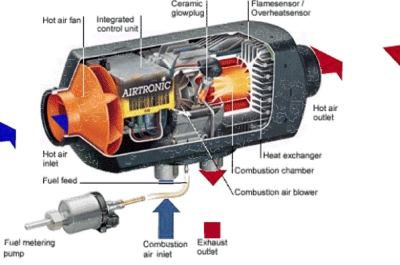 Here was the live-support system, yes
it looks ridiculous. It got down to -15 Celsius / 8F, it
worked phenomenally well. Here was the live-support system, yes
it looks ridiculous. It got down to -15 Celsius / 8F, it
worked phenomenally well. |
| The
passing of Steve Finberg |
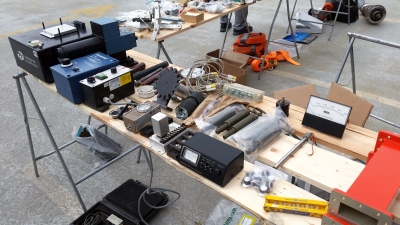 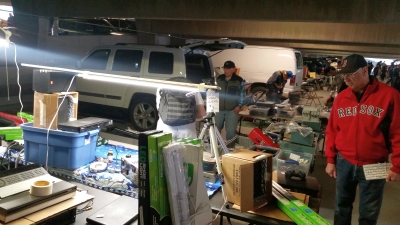 One of the early times visiting MIT
was the Swapfest. For those who have not experienced it,
well, its a very variable event. Everything from computer
parts to contraptions are for sale in flea-market format.
The event normally took place outside sprawling around
near the MIT Albany Street Garage open area and into the
garage as well. One of the early times visiting MIT
was the Swapfest. For those who have not experienced it,
well, its a very variable event. Everything from computer
parts to contraptions are for sale in flea-market format.
The event normally took place outside sprawling around
near the MIT Albany Street Garage open area and into the
garage as well. |
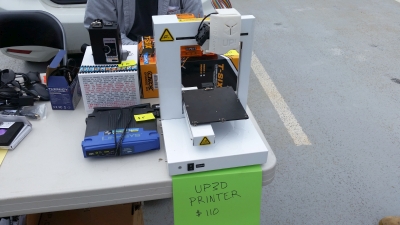 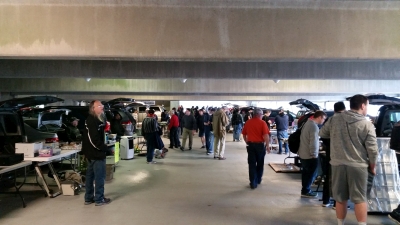 There were always interesting things,
some were at quite a bargain. You'd run into folks who you
had not seen in ages, get into strange conversations, and
meet interesting new people. Need a vacuum tube or a
really cheap WIFI access point? Swapfest has you covered.
Need a dish antenna for your homemade satellite receiver?
Swapfest has most of the parts but is missing the
reflector, its OK the gal upstairs may have one in her
pile of cruft. There were always interesting things,
some were at quite a bargain. You'd run into folks who you
had not seen in ages, get into strange conversations, and
meet interesting new people. Need a vacuum tube or a
really cheap WIFI access point? Swapfest has you covered.
Need a dish antenna for your homemade satellite receiver?
Swapfest has most of the parts but is missing the
reflector, its OK the gal upstairs may have one in her
pile of cruft. |
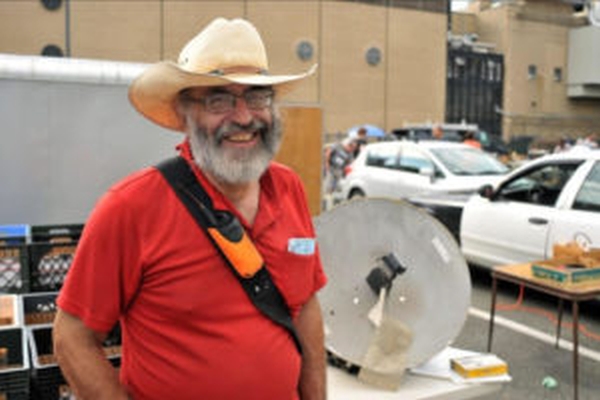 Steve Finberg was one of the big pillars of making the MIT Swap happen, he worked at Draper labs near MIT for ages. Steve would appear periodically in miters, handing you a stack of fliers to staples to buildings and dorms and telling tall tales of times long gone. One of my favorite photos with Steve was a late friday tearing apart a Sevcon prototype motor controller. W1MX, has a really nice writeup [link] |
| MIT Round
3 |
The inside of the Dome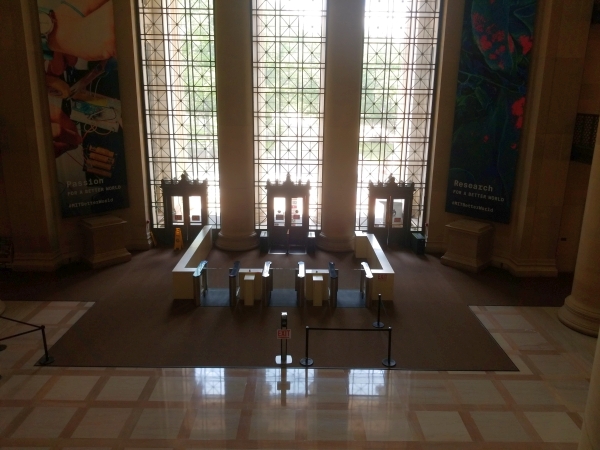 Here's what the inside of the mit dome on mass-ave looked like. The entrance was notoriously just open, there was no card access system built into it, so a barrier internally was added with card-access gates. A security officer was posted to the far left of the photo |
Updated
testing @ MIT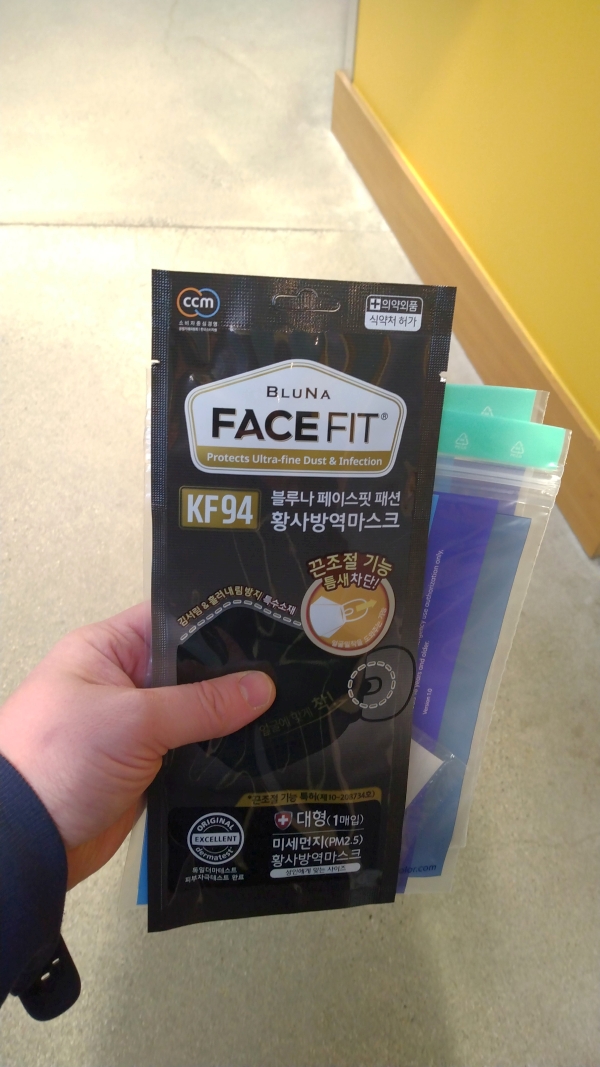 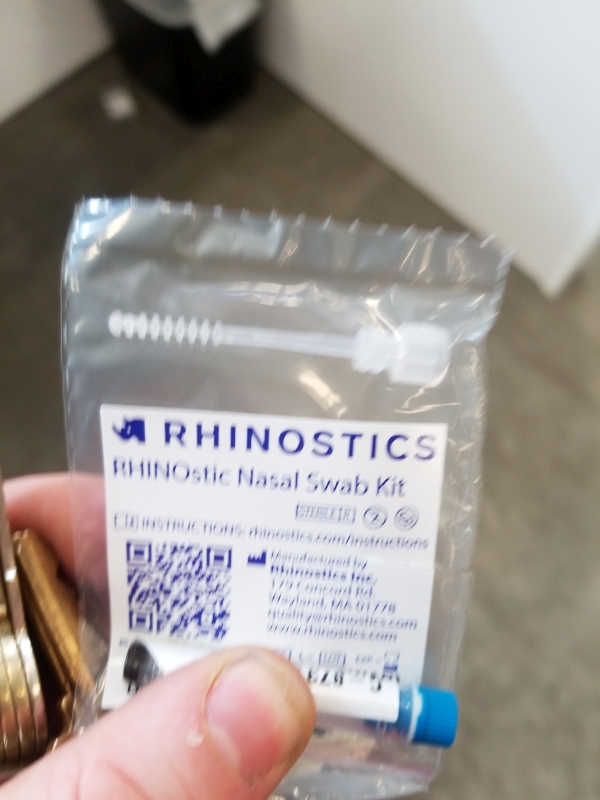 With the students back on campus testing switched from in-person (show up at two testing sites and be supervised during testing) to un-supervised. You get a kit which contains some details about the sample collection, inside that kit is another baggie with a nose swab. You correlate the kit barcode with your mit account, put the sample in the lil vial and then bring it over to a few collection points on-campus. Late January 2022 KF94 face masks were distributed as the omicron variant caused a fairly sizeable spike on campus. |
| Dane's Impromptu
Pandemic Audio-book review |
To Sleep in a
Sea of Stars - Christopher Paolini  [Wikipedia] [Wikipedia]
I was not expecting such a wild ride of a book. It really went everywhere, I went into this book without much detail about its plot which was great in retropspect, as it was really unpredictable. I listened to this as an audiobook, and i've found that the narrator really makes or breaks a book, fortunatley the narrator [Jennifer Hale], did a fantastic job. |
The
murder-bot series is frigging excellent. 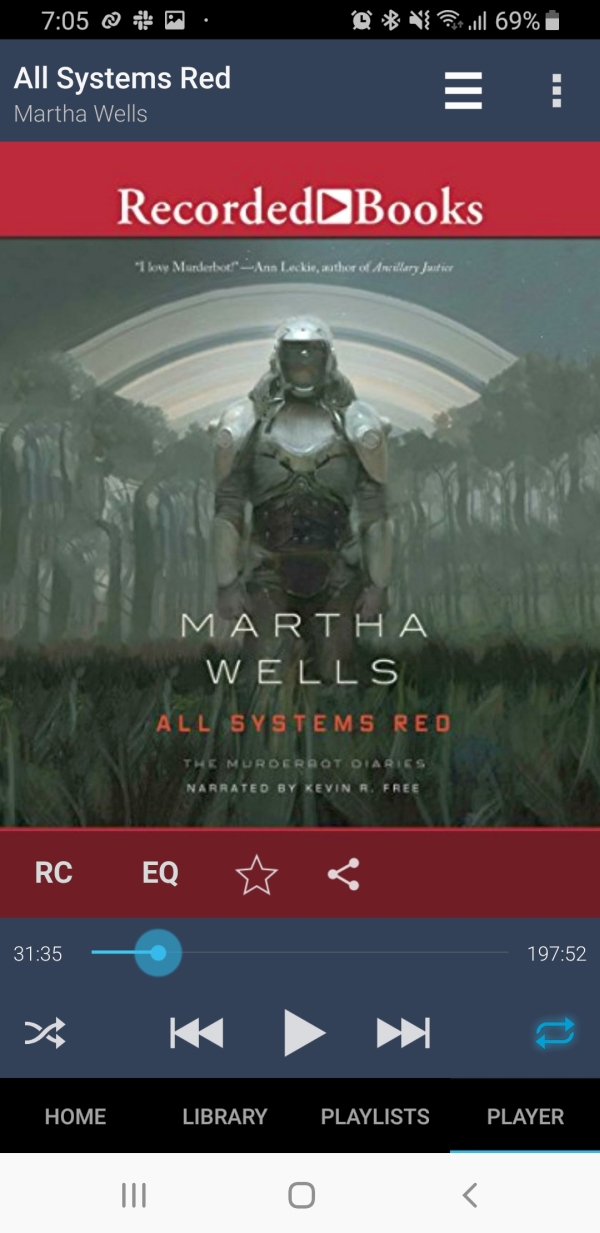 [Wikipedia] [Wikipedia]The universe that the book occupies is deep and fun. You follow a wayward machine-person as they escape the boundaries they are born into and explore whatever life is for a human masquerading as a robot masquerading as a human. The internal monologues are great, the somewhat ethereal questions are great and the narration is great. |
The
Ministry For The Future - Kim Stanley Robinson I really wanted to get thru this, but it was too darn depressing. I made it 11 hours in, but all the aspects of this book that I liked were hampered by this year, its just a difficult listen when you're isolated and the future looks bleak. It is incredibly long, and the length is drawn out by the depth and slow pace. I like the premise, eco-terrorists reclaiming the planet by force, but listening to this during early 2020 was rough. The voice acting was pretty good in the audio-book, they opted for eleven narrators. To keep each person different they really went to town on accents. |
Hail
Mary - Andy Weir Hail Mary was an interesting listen. Its difficult to keep the narrative exciting with just two characters, so the book uses a lot of flashbacks in the form of recovered memories. Our main character re-learns who he is during the process of trying to accomplish some comically involved activities. Even though there's a lot of back and forth, The story-line is easy to follow, the audio-book was really well 'voiced'. I really liked the polyphonic representations of Rocky's voice. This was a captivating listen. There is a mcguffen, a biological that allows for some ludicrous physics. You kinda need to just accept that it exists and not get hung up on how it exists. After that you're all set for a really curious ride. Some things that didn't quite work for me: * The magical Taumoeba which eats the Astrophage really heavily ignores any form of thermodynamics. The comically energy dense fuel (astrophage) just looses all of its energy to nowhere when killed by its predator. When a fuel tank accidentally gets infected by Taumoeba, its only described as being smelly, not you know tera-joules of energy radiating from every surface. |
The
space team series is 110% goofy [wikipedia] [wikipedia]The plot is ludicrous, the episodes are incredibly strange but it was a good change of pace. The bizarre situations made for a good distraction during the unending media chaos of 2020. There's also a lot of books in this series that are all tied together. |
(There's
other
photos in the photo gallery)
Concluding Remarks:- Hi
If you have questions or comments, ask below or send over an email.
| Comments: |
Comments |
Dane.Kouttron
Rensselaer Polytechnic
Institute
Electrical & Electrical
Power
631.978.1650
![]()
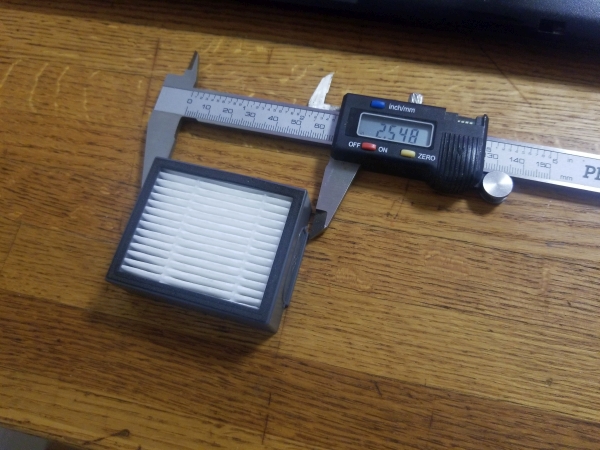
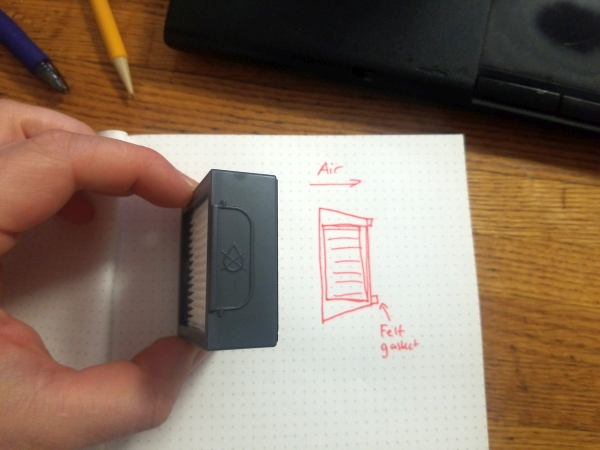
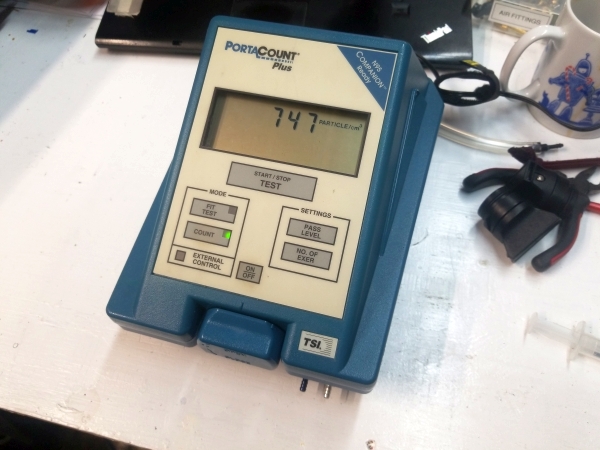
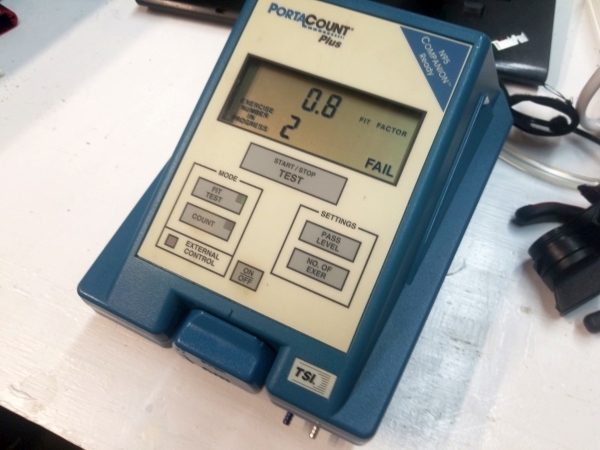
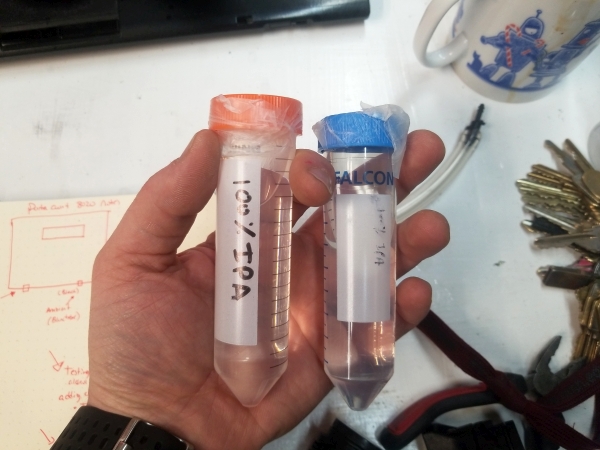
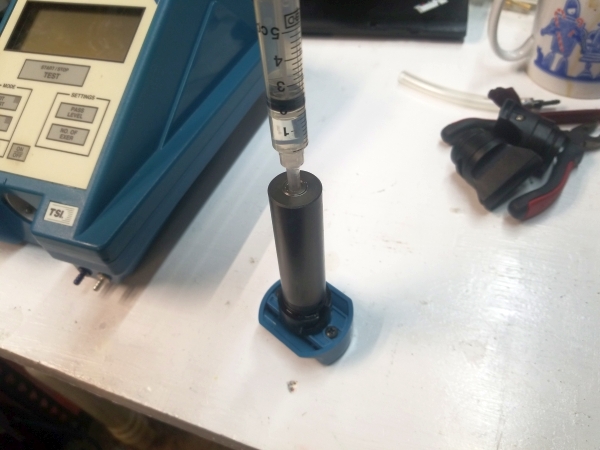
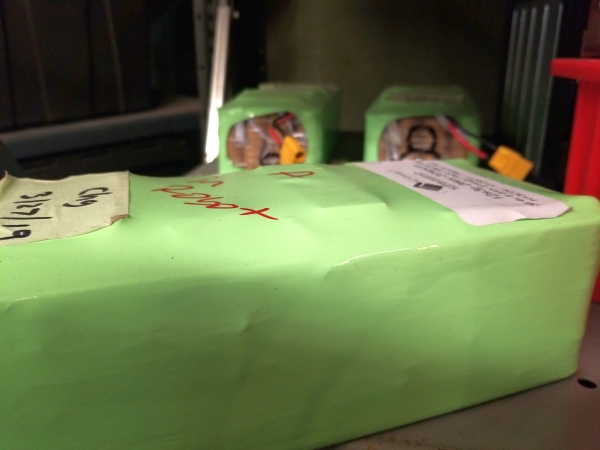
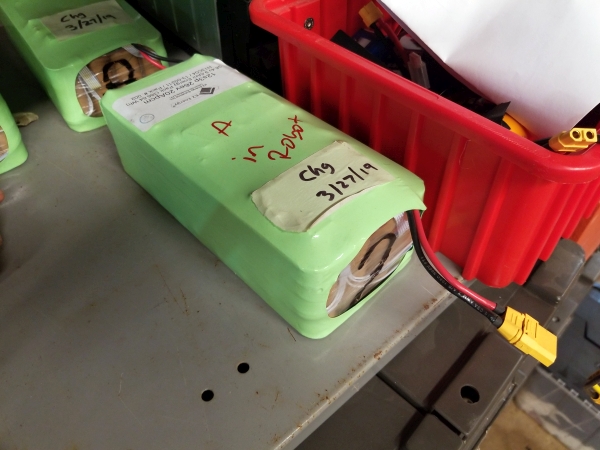
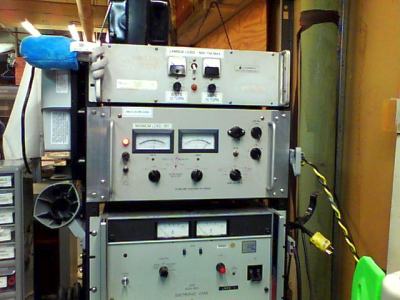
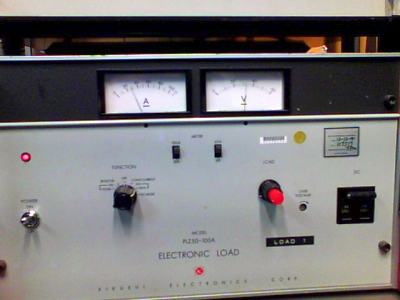
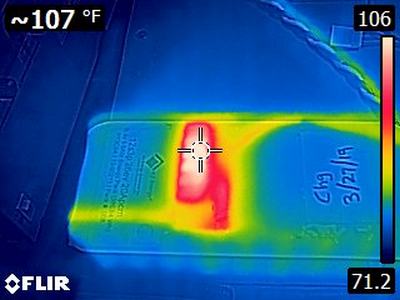
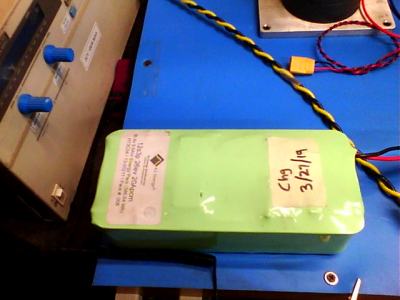
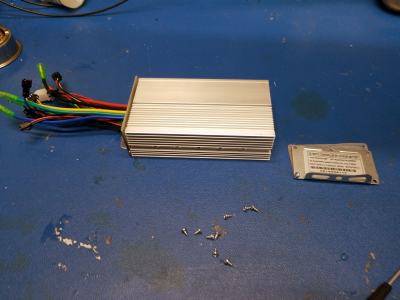
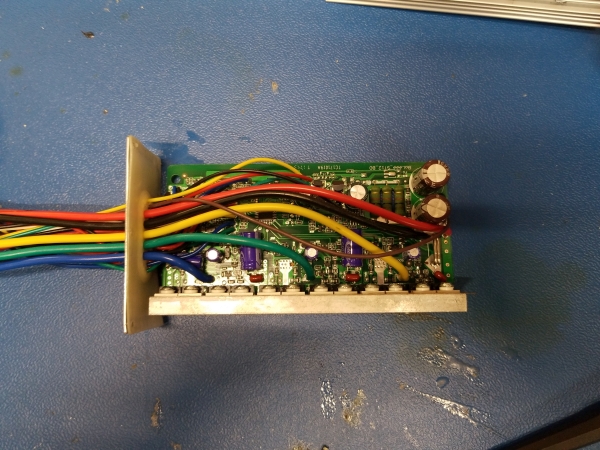
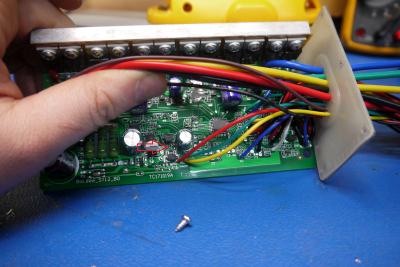
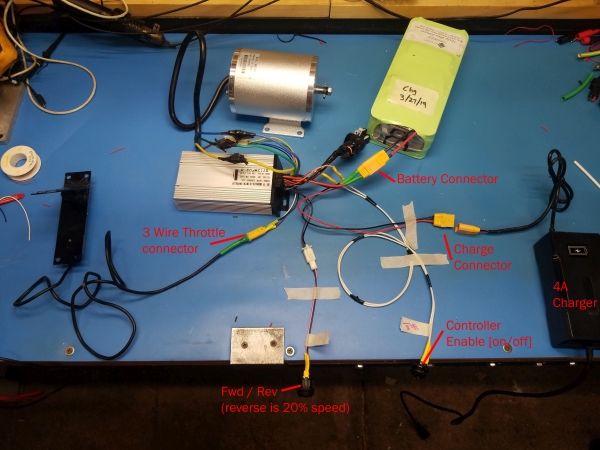
No one has commented yet. Be the first!